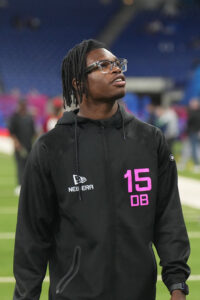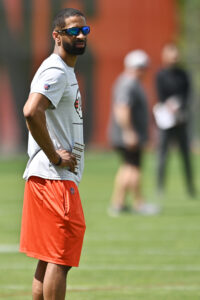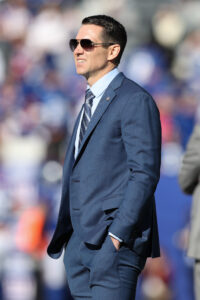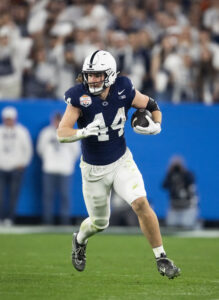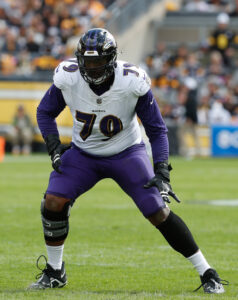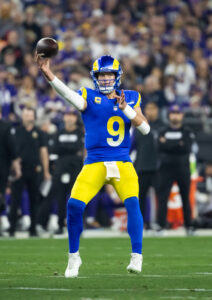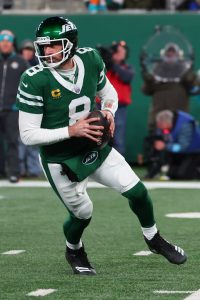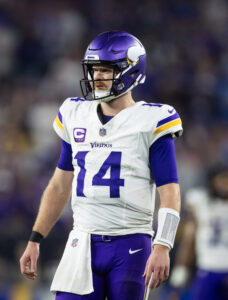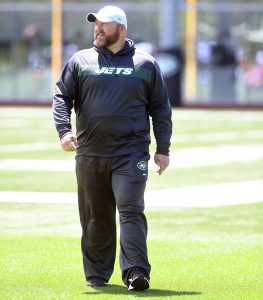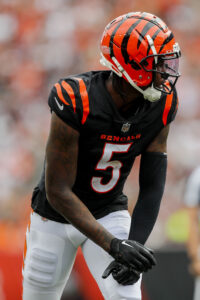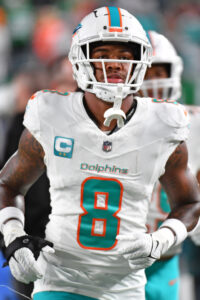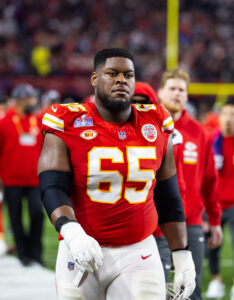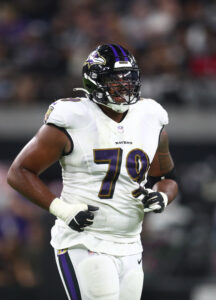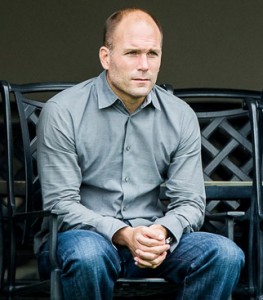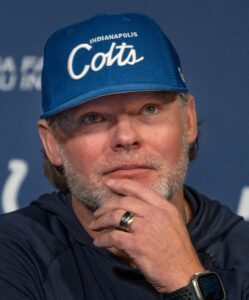Players who could be released at the start of the 2025 league year or soon after are not included, only those out of contract for the ’25 season appear below. Teams have until 11am CT March 10 to keep free agents-to-be off the market. In Year 33 of full-fledged NFL free agency, here are the top options for teams to target once the legal tampering period starts:
The quarterback tag has ballooned to $40.24MM, which proved to be too much for the Vikings to stomach. As Minnesota has a handful of starters nearing the market, circling back to Darnold at a (slightly) lower rate remains in play. But the Vikings will now run the risk of losing their 2024 J.J. McCarthy bridge, one that proved much sturdier than most expected.
Drawing a $4.5MM offer in 2023 (from the 49ers) and choosing the Vikings’ $10MM proposal last March, Darnold has made a remarkable rise to this place. While his surge can be compared to Baker Mayfield’s, Darnold’s 2018 draft classmate had shown extended flashes in Cleveland. Darnold washed out of New York and was not a priority in Carolina, with the Panthers instead making a monster trade to acquire a No. 1 overall pick that went to Bryce Young. Darnold bided his time and has received extensive tutelage in the Kyle Shanahan and Sean McVay (via O’Connell) offenses.
Darnold’s 35 touchdown passes last season eclipsed his career high by 16; his 66.2% completion rate was more than four points better than his previous top number. Darnold’s previous best before his 4,319-yard season: 3,024 with the 2019 Jets. It is easy to see why skepticism exists, as a multiyear guarantee at a Mayfield-level rate (at least) will be required. Overpaying free agents is a tried-and-true NFL tradition, but someone will take a chance on Darnold being the answer. Mayfield received $50MM in total guarantees – on a three-year deal. Darnold could push to top that on a four-year pact, as the salary cap has spiked by another $24MM since the Mayfield-Buccaneers agreement. A Daniel Jones-like guarantee at signing ($81MM) is probably too high, but Derek Carr‘s $60MM number (ahead of an age-32 season) may not be.
The Vikings have Jones as a backup plan, a solution that would effectively make the ex-Giant the 2025 Darnold behind McCarthy. It would not make too much sense for Darnold, with his value where it now is, to accept a multiyear Vikings pact due to McCarthy’s presence. Similarly, re-signing Darnold would cut into Minnesota’s ability to capitalize on McCarthy’s rookie contract. A tag represented the most logical option to keep Darnold in the Twin Cities; that deadline passing opens the door to one of the more interesting QB free agencies in recent history.
The seven-year veteran, who has 56 pre-Minnesota starts teams can judge, will slide in as a player whom clubs can talk themselves into as having a Mayfield- and Geno Smith-like resurgence. Both QBs have sustained their belated breakouts, and that will help Darnold. Though, Smith and Mayfield did not relocate after breaking through. Darnold would be best positioned to sustain his by remaining a Viking, but McCarthy – whom the Vikings built their 2024 offseason around – has tremendous internal support. Bigger money should await elsewhere.
Fairly well regarded going into 2024, Sweat still needed to accept a pay cut to stay with the Eagles. As the team rearranged its defensive line after Fletcher Cox’s retirement, it opted to retain Sweat and swap out Haason Reddick for Bryce Huff. The latter’s $17MM-AAV contract is teetering on bust status, as he was a healthy scratch for Super Bowl LIX. Fortunately for the Eagles, they could rely on Sweat, who cemented his value with a dominant performance to expose All-Pro guard Joe Thuney as miscast at left tackle and remind suitors about a promising combination of production and prime years remaining.
Unlike Barrett, Sweat has no sack title on his resume. One double-digit sack season appears there; his 11-sack 2022 helped the Eagles threaten the 1984 Bears’ single-season record. Sweat leaving Philadelphia would stand to move all four of the double-digit sack performers from that ultra-productive season off the Eagles’ roster, with Brandon Graham expected to retire.
Sweat may become too expensive for an Eagles team, as creative as they are with contract structure, to afford. They are expected to lose their top EDGE. The Eagles have Nolan Smith in place as a starter and, theoretically, Huff at the other spot. Third-rounder Jalyx Hunt, who joined the Super Bowl sack brigade, is likely to see his role expand if Sweat departs (that is, if the Eagles cannot swing a Myles Garrett blockbuster).
After back-to-back seasons of 23 QB hits, Sweat only compiled 15 during his eight-sack 2024. That sack total still led the Eagles, whose defensive blueprint smothered the Commanders and Chiefs as the team peaked at the ideal point. Sweat’s 16 pressures still ranked only 92nd this past season, after his 37 in 2023 checked in 10th. The Super Bowl, however, probably put to rest any doubts about Sweat’s difference-making abilities, as the Chiefs had kept Mahomes cleaner for much of Thuney’s tackle stretch.
Interior defensive line-wise, this is not a deep group of free agents. Especially after the Cowboys took Osa Odighizuwa off the market via a four-year, $80MM deal. That will help Williams, even though he does not have a take-notice resume, stats-wise. PFF, however, rated him as the No. 1 overall pass rusher among interior D-linemen. Williams will be a player to watch for a sneaky-big contract agreement.
Not ultimately rewarding the Ravens for their then-top-market extension in 2020, Stanley both hurt his third-contract value while attached to that accord and belatedly saved face with a 2024 rebound. The Ravens gave Stanley a significant pay cut, reducing his base salary by $7.5MM, last year. The former No. 6 overall pick responded by playing in a career-high 17 games and earning his second Pro Bowl nod. Last season will not be enough to completely erase the previous four – which injuries largely defined – but Stanley is a talented player at the O-line’s premier position.
Had Stanley not sustained that injury in Week 6 of the 2020 season, he almost definitely would not be hitting free agency now. As the Bills (Dion Dawkins), Broncos (Garett Bolles) and Lions (Taylor Decker) showed last year, teams have a habit of keeping quality LTs off the market on third contracts. Those deals came between $20MM and $20.5MM per year. As our Nikhil Mehta pointed out, that could establish a clear price range for Stanley.
The Ravens, who lost three O-line starters last year, want to keep him. Will they be able to? Compensatory picks have regularly dictated Baltimore’s free agency strategy, but letting Stanley walk would create a big need – in an offseason in which versatile blocker/former Stanley sub Patrick Mekari is also unattached.
5. Cam Robinson, LT. Age in Week 1: 29
A left tackle with eight years of starter experience hitting free agency at 29 without his team having a place for him is rare, but after Robinson became the Vikings’ emergency Christian Darrisaw fill-in, he is headed to the market for the first time. And he is now doing so after the Rams reached an agreement to re-sign Alaric Jackson. As this space removed Jackson from this sector of the list, Robinson looks to be one of the chief beneficiaries.
 The Jags franchise-tagged Robinson twice earlier this decade, leading to a three-year, $52.75MM deal he finished in Minnesota. With some LT free agents-to-be already taken off the board last year (Garett Bolles, Taylor Decker), Robinson will be a more attractive option – especially as Ronnie Stanley is 31 and a risky investment due to his injury past.
The Jags franchise-tagged Robinson twice earlier this decade, leading to a three-year, $52.75MM deal he finished in Minnesota. With some LT free agents-to-be already taken off the board last year (Garett Bolles, Taylor Decker), Robinson will be a more attractive option – especially as Ronnie Stanley is 31 and a risky investment due to his injury past.
Robinson is a zero-time Pro Bowler, but veteran LT starters do not regularly surface in free agency in their 20s. The Jags made their choice, going with a cheaper Walker Little contract – one authorized by soon-to-be fired GM Trent Baalke – so a Jacksonville return is off the table. Robinson started 91 games for the Jags, helping Trevor Lawrence develop, and shook off injury concerns last season by lining up for 17 games between his Jacksonville and Minneapolis stays.
PFF slotted Robinson outside the top 50 among tackles last season, and his 88.2% pass block win rate did not wow. But the 6-foot-6 blocker is on the open market in his prime. That gives the Alabama alum a lane toward a Bolles- or Decker-level deal; both veterans inked $20MM-per-year accords in 2024. Something between that pact and the ones Jake Matthews and Kolton Miller are tied to ($18.5MM and $18MM AAV, respectively) could be where this settles, but with the cap rising, a bet on Robinson becoming the league’s ninth active $20MM-per-year LT should not bring long odds.
6. Jevon Holland, S. Age in Week 1: 25
Teams are being more careful at safety. Rather than the market exploding, it continues to increase incrementally. The past two free agency periods have been responsible for the gap widening between the top-market anchors and the middle class. The 2023 offseason brought one safety offer north of $8MM per year; the Falcons gave Jessie Bates a four-year, $64MM deal. Last March, the trend repeated; the Packers submitted a four-year, $67MM offer to Xavier McKinney. Both players justified the costs, with Bates earning second-team All-Pro acclaim in 2023 after a six-interception season and McKinney snaring a first-team nod (following an eight-INT slate) in 2024.
This year’s market brings a familiar dynamic, as Holland appears set to follow the Bates-McKinney track and collect an upper-crust safety pact. For the Dolphins, this would be familiar territory. Not franchise-tagging Holland, the Dolphins look likely to see him bolt for a top-five contract elsewhere after Christian Wilkins and Robert Hunt did so in 2024. Miami cap issues led both linemen out of town. Although Chris Grier drafted Holland, he was added to play in Brian Flores’ defense. And the Oregon product is close to relocating.
Not delivering takeaways on the Bates or McKinney level yet, Holland still has made his presence known with turnovers. He has five career INTs, five career forced fumbles and four recoveries. The effective blitzer also has five career sacks. He has managed this despite the Dolphins employing three defensive coordinators in his four seasons. PFF viewed Holland as playing better under Vic Fangio, grading him third among safeties in 2023, than Anthony Weaver (56th). Like Hunt and Wilkins, Holland will be a chief beneficiary of a cap spike. A safety-needy team with money to burn is almost certain to pay near-top-market money.
Antoine Winfield Jr. set a new safety record last spring by securing a $21MM-per-year contract on the franchise tag. Holland has the open market to his advantage and going into his age-25 season makes him a stealth candidate to eclipse the All-Pro. Free agency regularly reminds that a player does not need to be the best at his job to become his position’s top earner. Even if Holland cannot clear where Winfield went, settling in between he and Derwin James’ $19MM-AAV accord will probably be attainable.
7. Chris Godwin, WR. Age in Week 1: 29
A sought-after free agent hitting the market often brings a team change. After all, clubs have an extensive window to negotiate exclusively with players. If they are unsigned when the legal tampering period begins, new plans generally need to be made. The Buccaneers have proven the exception. They have mastered this timeline, letting players play out their deals before keeping them despite bidding against other teams. Jason Licht has pulled this off with top-tier free agents (Shaq Barrett, Carlton Davis, Jamel Dean) this decade, letting each hit the market and bringing them back, while reaching 11th-hour deals to retain Mike Evans and Baker Mayfield last year.
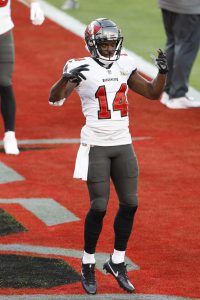 Godwin is an interesting case due to his injury past and the Bucs’ recent draft work. The longtime Evans sidekick suffered ACL and MCL tears in 2021, but he still returned in Week 1 of the 2022 season and added his third and fourth career 1,000-yard showings while on this deal. As he looked finally back in top form last season, a dislocated ankle marred the resurgence.
Godwin is an interesting case due to his injury past and the Bucs’ recent draft work. The longtime Evans sidekick suffered ACL and MCL tears in 2021, but he still returned in Week 1 of the 2022 season and added his third and fourth career 1,000-yard showings while on this deal. As he looked finally back in top form last season, a dislocated ankle marred the resurgence.
The Bucs also drafted Jalen McMillan in the third round and saw him flash alongside Evans down the stretch, seeing him snare seven of his eight TD receptions over the final five weeks of the regular season. In addition to rewarding deeper-league fantasy GMs during that span, McMillan showed potential to stick as a lower-cost WR2 next season. But the Bucs are quite loyal; they want Godwin back on a third contract.
Despite not flirting with WR1 numbers on his second contract (three years, $60MM) after being hit with the franchise tag twice, Godwin is on his own tier in terms of production between Evans and the field in Bucs history. His 7,266 career receiving yards are more than 2,000 clear of Mark Carrier for second in team annals. The Bucs moved off the ledge with Evans, going from near-separation to a two-year, $41MM third contract.
As Evans is back in a platform year, the team could view Godwin as a younger player who could take his place leading a receiving corps that includes McMillan, then, in the Godwin WR2 role post-2025. Though, the Bucs have a midlevel QB contract (Mayfield’s three-year, $100MM deal) to work around, potentially providing flexibility for a fourth Evans pact and a third Godwin agreement.
A four-time 1,000-yard receiver, Godwin did lose some ground during the failed Antonio Brown experiment. Months after the future second- or third-ballot Hall of Famer’s New Jersey meltdown, the Bucs tagged and extended Godwin. He has shown ability to play outside and in the slot, and with Tee Higgins re-tagged, the eight-year Buccaneer is suddenly the top WR available. Injuries might reduce Godwin’s value, but he still has an age-29 season to market. That will test the Bucs’ routine of March player retention.
8. Justin Fields, QB. Age in Week 1: 26
The moving parts that led Fields out of Chicago prove even more interesting today. It took a Lovie Smith middle finger to the Texans, a game-winning two-point conversion try to seal a Week 18 victory over the Colts, on his way out gave the Bears the 2023 No. 1 pick. Chicago not deeming Bryce Young or C.J. Stroud as worthy of upending its Fields plan led the team to send the Panthers the top pick for a bounty that included D.J. Moore and what became the 2024 No. 1 pick. Had the Panthers simply regressed from their 7-10 Steve Wilks-led season and not cratered in 2023, the Bears likely retain Fields – in a chain reaction that would have then sent Caleb Williams to Washington, etc.
 Simply put, it took a lot to move Fields out of Chicago last year. It is not that the 2021 No. 11 overall pick was especially good – passing-wise, that is – but starter-level QBs heading into mid-20s seasons are not commonly traded (the Bears were on the other end of one example after the 2009 Jay Cutler-Josh McDaniels saga). Fields did not seize the Steelers’ starting job from Russell Wilson last year, but he closed the gap. The Steelers’ party line centered around Wilson as the surefire starter last summer, but Fields gained support in the building – to the point Mike Tomlin needed to overrule certain staffers to give Wilson the job once his calf injury finally healed in October.
Simply put, it took a lot to move Fields out of Chicago last year. It is not that the 2021 No. 11 overall pick was especially good – passing-wise, that is – but starter-level QBs heading into mid-20s seasons are not commonly traded (the Bears were on the other end of one example after the 2009 Jay Cutler-Josh McDaniels saga). Fields did not seize the Steelers’ starting job from Russell Wilson last year, but he closed the gap. The Steelers’ party line centered around Wilson as the surefire starter last summer, but Fields gained support in the building – to the point Mike Tomlin needed to overrule certain staffers to give Wilson the job once his calf injury finally healed in October.
Taking sacks at a near-Wilson-level rate – the Steelers sure eschewed that element of quarterback play when assembling last year’s depth chart – Fields matched his 2023 yards-per-attempt figure (6.9) and finished with a 5-1 TD-INT ratio. This was a low-octane offense that dealt with Fields’ limitations, but the Ohio State alum still established a new career best in completion percentage by more than four points (at 65.8). Fields also sits second for QB rushing yards in a season, churning out 1,143 in a 2022 season that may have seen him break Lamar Jackson’s record (1,206) had the tanking Bears not sat him for Nathan Peterman in Week 18.
Fields’ aerial struggles were apparent in Chicago previously. Per ESPN, Fields ranked last out of qualified passers with a 51.8% fourth-stanza completion rate while sitting 30th in QBR in final periods from 2021-23. In that span, Fields’ 16 fourth-quarter INTs led the league. Not dispelling concerns in this area last season, Fields has the age advantage (as Jim Lampley would say) on the other starter-level QBs hitting free agency. With several teams needing a quarterback in a year featuring a maligned draft class at the position, we appear headed well beyond merely a “prove it” contract for the Ohio State product.
The Steelers’ antiquated rule that prevents in-season negotiations left them less time to work out a deal with either Fields or Wilson. Because of age, Fields entered March with the apparent upper hand to stay. If he reaches the open market when the legal tampering period launches Monday, the Steelers may have competition to battle. The Colts, Giants, Jets and Raiders have been linked to pursuits. Two of the QB-needy teams will address their deficiencies with Cam Ward and Shedeur Sanders; the rest need to be creative.
This will probably be the 2025 free agency period’s most interesting market. While Wilson, Kirk Cousins and Aaron Rodgers will be available starters, all are near the end of their careers. Fields still offers untapped potential – even if his ceiling has probably lowered since being drafted – and top-tier rushing skills at the position. Even with Darnold hitting the market, Fields will have a starter opportunity. This offseason has brought steady momentum for a player who spent two-plus months as a backup in his fourth season, making for an unusual mid-career arc.
9. D.J. Reed, CB. Age in Week 1: 28
The best combination of age and proven quality play on this year’s cornerback market, Reed saw his path to free agency become clear when the Jets paid slot corner Michael Carter last summer. Sauce Gardner is an obvious extension candidate, pointing Reed out of town and New York to identifying a cheaper CB2. This will mark a second Reed crack at upper-crust CB money, as the value of a three-year second contract strikes again.
Reed joins Charvarius Ward, Byron Murphy, Carlton Davis, Rasul Douglas and Mike Hilton as prominent third-contract-seeking CBs on this year’s market. While Douglas and Hilton are in their 30s (or will be by Week 1), the younger quartet should fare well. Even as the run game received a jolt in 2024, this is still a quarterback-driven sport; and many teams have issues stopping them. For Reed, this continues a rebound, as the 49ers cut him early during his third training camp. The 2018 fifth-round pick has since played well for the Seahawks and Jets, potentially opening the door to a reunion with one of the since-relocated New York defensive coaches (Robert Saleh, Jeff Ulbrich).
Among boundary corners to start at least 10 games last season, Reed ranked 11th in yards per target (6.4). The same measurement in 2023 places Reed (6.6) 12th. PFF ranked Reed 16th among CB regulars in 2023 and 31st in ’24. Many teams rank Reed as this year’s top CB available. Reed improved his completion percentage allowed as the closest defender to 57.1 last season, a Jets-years high for him. While just 5-foot-9, the former Day 3 draftee has been a consistent deterrent, having broken up 40 passes since 2021. He has also remained durable, starting at least 14 games since that 2021 breakthrough.
Chidobe Awuzie led the way for third-contract-seeking CBs last year, scoring a three-year deal worth $36MM ($19MM guaranteed at signing). Thirteen of the top 14 CB deals are tied to players on their second contract; this position does not see nearly as many quality seasons post-30 as wide receiver does. Reed will turn 29 in November, limiting the upside here. But he is competing with a host of similar players on this market. A deal north of Awuzie’s would be likely, as the ex-Cowboys and Bengals starter was coming off an injury-marred Cincinnati tenure.
10. Nick Bolton, LB. Age in Week 1: 25
Not possessing ideal size (237 pounds) at the position, especially in an NFL that has seen schemes’ prevention of the deep ball rejuvenate rushing approaches, Bolton has been the centerpiece of Kansas City’s defensive second level throughout his career. The Chiefs have prioritized Trey Smith this year, making him only the third guard franchise-tagged over the past 14 offseasons. That will make it quite difficult for the three-time reigning AFC champs to retain one of their other gems from the 2021 draft. With Smith cuffed via the tag and Creed Humphrey extended on the league’s top center deal, Bolton appears likely to follow Willie Gay out of town.
 The Chiefs have managed to maintain their status as the NFL’s most reliable team – Super Bowl LIX notwithstanding – despite a regressing offense. Yes, officiating breaks have come their way, but the AFC West superpower has also carried an above-average defense into each of its five Patrick Mahomes-era Super Bowls. Bolton became a central Steve Spagnuolo piece via the 2021 second round, and his 180-tackle 2022 ended with a Super Bowl LVII touchdown (and second TD reversed via replay).
The Chiefs have managed to maintain their status as the NFL’s most reliable team – Super Bowl LIX notwithstanding – despite a regressing offense. Yes, officiating breaks have come their way, but the AFC West superpower has also carried an above-average defense into each of its five Patrick Mahomes-era Super Bowls. Bolton became a central Steve Spagnuolo piece via the 2021 second round, and his 180-tackle 2022 ended with a Super Bowl LVII touchdown (and second TD reversed via replay).
The agile LB functions well against the run and posted a top-20 coverage grade (per PFF) last season. He added 11 tackles for loss in 2024, matching his 2022 total (two injuries cost the Mizzou alum eight games in 2023). He added six passes defensed last season.
Like the safety market, the inside linebacker landscape has not seen a surge as of late. Two players tied to top-market contracts – C.J. Mosley, Foye Oluokun – accepted pay cuts in exchange for guaranteed money last year. This came after Shaquille Leonard’s injury trouble led him out of the league in 2023. This left only six players signed for at least $12MM per year at the position. Bolton has a good chance at being the seventh soon.
Azeez Al-Shaair was nearly two years older than Bolton when he collected a three-year, $34MM Texans deal, and Baun just scored a top-five ILB contract at 28. Bolton should be able to at worst push land in between these two deals and has a case to push toward the Baun number, as it can be argued he was the third-most important player on the defenses that produced three straight Super Bowl berths. The Chiefs going back to the Mahomes restructure well, which they have already explored thrice thanks to the QB’s through-2031 contract, may be wise to retain Bolton. Though Spagnuolo has continued to replace linebackers and get by without a high-end contract there (much like the team does at CB), losing Bolton would be difficult.
11. Byron Murphy, CB. Age in Week 1: 27
As it turned out, we were too high on Murphy in 2023. He settled for a two-year, $17.5MM Vikings deal and became a key component of their defensive progression under Brian Flores. The former Cardinals cog started 31 games with the Vikings and intercepted nine passes, six coming last season as Minnesota deployed a complex defense that helped supplement its Sam Darnold-dependent season. Pro Football Focus ranked Murphy as a top-25 corner in 2024, as he improved in yards per target (7.2) and passer rating allowed as the closest defender (76.7) compared to his first Minnesota season.
Most importantly, Murphy is hitting free agency at 27. Despite being among the corner contingent looking for a third contract, the former second-round pick has age on his side. The 5-11 cover man also has been durable, missing more than three games in a season just once (2022). After two healthy Minnesota seasons, Murphy should be in better position to cash in, and the Vikings want to retain him. A recent report suggesting he is targeting $20MM-plus per year (a stratosphere only five corners populate, with Jaire Alexander soon to be removed from this club) does complicate this.
He has extensive slot experience, playing there more in Arizona but still seeing 307 snaps inside last season. Murphy is among a few high-profile free agents on the Vikings’ roster; how the team proceeds with Darnold will determine the viability of Murphy, Camryn Bynum and Aaron Jones returning. A path in which the Vikings let Darnold walk and circle back to Daniel Jones as J.J. McCarthy insurance would open the door wider to retaining Murphy and Bynum.
How this collection of late-20-something corners fares will be one of this free agency period’s more intriguing storylines, and it will help shape how the position is viewed at the decade’s midpoint. Murphy’s two-year deal from 2023 reminds of a high school recruit taking the JUCO route before reassessing. A stronger market should be there this time around, and although the six-year veteran is younger than most of his FA peers, he is running out of time to land a true upper-crust CB contract. It may be now or never.
12. Dayo Odeyingbo, DL. Age in Week 1: 25
As outdated as analyzing base schemes may be, Odeyingbo ending up as a 3-4 defensive end would be interesting. His 6-foot-6, 286-pound frame would support such a landing spot, as the former second-round pick oscillated between D-end and D-tackle in Gus Bradley’s 4-3 defense. The past two years represented big steps forward for the Purdue alum, who came into the NFL after suffering an Achilles tear three months before the draft.
Odeyingbo’s traits attracted the Colts, and they will bring other teams to the table soon. The versatile performer could be tabbed a ‘tweener, but his past playing inside and out may also be a resume-booster. Throwing out his injury-delayed rookie season, Odeyingbo has totaled 21 tackles for loss and 45 QB hits. He posted eight sacks in 2023, playing 210 snaps on the inside (compared to 162 in 2024), as the Colts finished with 51 sacks – fifth-most in the league. The young D-end combined for eight sacks between the 2022 and ’24 seasons and has forced four fumbles over the past two years.
A team that signs Odeyingbo will need a defined plan for the multi-position performer, but it is not hard to see the combination of frame, production and flexibility intriguing a few DCs. The Colts have been perhaps the headquarters of building from within during the Chris Ballard era, but after the embattled GM suggested a philosophical shift to start the offseason, it seems more likely this homegrown Colt departs. The team has DeForest Buckner, Grover Stewart and Laiatu Latu signed for at least two more seasons and still holds contracts on Kwity Paye and Samson Ebukam through 2025.
13. Dan Moore Jr., T. Age in Week 1: 26
Doubling down at tackle during the past two first rounds, the Steelers effectively informed Moore he would be a one-contract player in Pittsburgh. The team had placed Moore in competitions to merely keep his left tackle job in 2023 and ’24, but each battle did not feature a serious threat to the former fourth-round pick. Not a highly regarded tackle, Moore is early in what should be his prime and has proven durable and resilient. He was the Steelers’ most dependable tackle last season.
 Moore posted an interesting season in 2024. He placed 11th in pass block win rate and convinced PFF’s evaluators he was not, in fact, a bottom-tier performer. PFF had viewed Moore as a poor tackle from 2021-23. While not assessing him near the Pro Bowl level, the advanced metrics site placed the Texas A&M alum 42nd at the position his contract year.
Moore posted an interesting season in 2024. He placed 11th in pass block win rate and convinced PFF’s evaluators he was not, in fact, a bottom-tier performer. PFF had viewed Moore as a poor tackle from 2021-23. While not assessing him near the Pro Bowl level, the advanced metrics site placed the Texas A&M alum 42nd at the position his contract year.
That said, Moore was charged with allowing an NFL-high 12 sacks last season. This can partially be traced to blocking for two historically sack-prone QBs, in Russell Wilson and Justin Fields. But Moore also was tagged for eight sacks allowed in 2023. Pass-pro issues will be scrutinized as teams determine if a midlevel tackle pact is worthwhile. Moore also helped Najee Harris deliver four straight 1,000-yard rushing seasons and was not the player benched for Broderick Jones in 2023, as the Steelers parked then-RT Chukwuma Okorafor.
Moore is a mid-20-something left tackle who has started for four years. This is not a Luke Joeckel situation where those starter seasons featured considerable underachievement. The Day 3 find has started all 66 games he has played, being the left tackle for three playoff teams. This will be one of the tougher markets to predict, but Moore is much younger than Ronnie Stanley or Cam Robinson. Alaric Jackson ,who signed a three-year deal worth $57MM, probably has a higher ceiling. But the recently re-signed Ram also does not carry Moore’s experience.
There is not much of a middle class at left tackle. Fifteen LTs earn at least $12.8MM per year. None are between $7.5-$12.5MM AAV. Moore has a great chance to at worst bridge that gap, and considering where the cap has gone, potentially do better – even if he will land in that zone where the handful of LT-needy teams will consider turning to a draft pick over a midlevel tackle signing. If teams are hesitant on Moore, a short-term deal reminding of the Cardinals’ Jonah Williams pact (2/30) could be in play as well. That would give Moore a chance to reestablish value, but there is also a chance he will not have to.
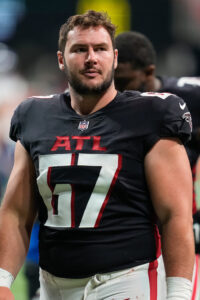 14. Drew Dalman, C. Age in Week 1: 26
14. Drew Dalman, C. Age in Week 1: 26
Despite coming into the league as a fourth-round pick, Dalman beat out Atlanta’s incumbent center (Matt Hennessy) in 2022 and held the job for the rest of his rookie deal. The center position continues to be undervalued, as the market still has just one player (Creed Humphrey) over $14MM per year. Of all non-kicker/punter/long snapper positions, this spot is in the worst shape. Even running backs, after a bounce-back 2024, have caught up.
Lloyd Cushenberry paired three shaky seasons with one promising slate to score what was then the second-highest guarantee ($26MM) at the position. Creed Humphrey came in with a market-topper that cast Cushenberry and Frank Ragnow’s deals as second-tier agreements, but with the cap still climbing at a much higher rate compared to what the 2011 CBA generated, effective but unspectacular players will benefit in free agency. Dalman qualifies. Center-needy teams will need to prepare an eight-figure-per-year deal – there are still just five of those at center – to land him.
PFF graded Dalman as a top-four center in 2023 and had him back there in ’24, though he missed eight games due to an ankle injury. At 300 pounds, the Stanford alum is more technician than road grader. But he still started in two offensive systems on his rookie deal. Dalman may not be the player to drag the center market toward the Humphrey stratum, but reaching the open market at 26 should provide a chance for the three-year starter to mix in near the Ragnow-Cushenberry-Erik McCoy level.
15. Davante Adams, WR. Age in Week 1: 32
Spending his career primarily tied to one quarterback, Adams would be wise to expand his destination list. Aaron Rodgers will be 42 by year’s end, and while the duo has undeniable chemistry, a host of contenders could benefit from a hired-gun version of Adams. Even as the Jets spiraled to 5-12, seeing their third-round pick exchanged for Adams fail to stop their descent, the midseason acquisition put up 854 receiving yards and seven touchdown receptions in 11 games with the team.
Adams outperformed DeAndre Hopkins and Amari Cooper, lapping the duo with his post-trade production. While his becoming available could throw a wrench in those two players’ respective free agencies – along with those of Stefon Diggs and Keenan Allen – this will be a key storyline to follow, potentially impacting the arms race that has formed in the AFC. As the Bengals are pot-committed at receiver, the Chiefs, Bills and Ravens represent interesting destinations for Adams on a short-term deal.
 Kansas City’s cap situation may provide too high a hurdle, barring a steep discount, as the team already needs to carve out money for Trey Smith’s franchise tag by the March 12 cap-compliance deadline. The Bills just paid Khalil Shakir, but Adams would step in as a better version of Cooper – though, Cooper’s Buffalo target share last season may spook Adams. The Ravens got by without replacing Odell Beckham Jr. last season; Adams would be a souped-up version of the injury-prone nomad.
Kansas City’s cap situation may provide too high a hurdle, barring a steep discount, as the team already needs to carve out money for Trey Smith’s franchise tag by the March 12 cap-compliance deadline. The Bills just paid Khalil Shakir, but Adams would step in as a better version of Cooper – though, Cooper’s Buffalo target share last season may spook Adams. The Ravens got by without replacing Odell Beckham Jr. last season; Adams would be a souped-up version of the injury-prone nomad.
Unless Adams is interested in again rejoining Derek Carr – whose team pursued him at the 2024 deadline – he should have a few options that do not involve Rodgers or Carr. Already linked to playing in his native California for the first time since college, the 11-year veteran could certainly help the Chargers. The Rams have also shown a willingness for splash moves, and wanting to give Matthew Stafford a less injury-prone weapon (compared to 2025 trade chip Cooper Kupp) now that he has recommitted would also make sense. The Rams also just moved off Jonah Jackson’s $17MM-per-year contract.
Crafting a Hall of Fame-level resume, Adams saw his choice to join the Raiders – over a more lucrative Packers offer (though, the guarantees were never known in Green Bay’s proposal) – backfire, draining two seasons from his prime. Three have now elapsed without a playoff berth, as Adams went from No. 1 receiver on three straight Packer teams that earned a playoff bye to a stat compiler for sub-.500 squads. This free agency may represent the three-time first-team All-Pro’s last chance to catch on with a Super Bowl contender while being paid appropriately.
Hopkins signed a two-year, $26MM Titans deal ahead of his age-31 season, while Beckham secured $15MM guaranteed before he turned 31. The best recent comp here, however, should be the Buccaneers’ 2024 Mike Evans deal. Tampa Bay kept the best receiver in franchise history off the market with a two-year, $41MM deal that came with $29MM fully guaranteed. Evans signed that deal months before his 31st birthday. Not every team will be willing to propose this deal, but Adams should target it. For all the recognition Evans has received for his 1,000-yard streak, Adams’ peak was much higher, as the Bucs wideout has no first-team All-Pros on his resume.
After Netflix documented Adams’ misery during a 2023 season spent without either Carr or Rodgers, the Fresno State alum is both unlikely to land somewhere without a proven quarterback and unlikely to overcommit. He boxed himself in with the five-year, $140MM Raiders deal, as three- and four-year pacts became the norm soon after. But Adams forced his way out of Las Vegas and has now seen a New York restart send him to free agency for the first time. Although Adams may only have a couple of seasons remaining in his career, he has stayed mostly injury-free and could shake up the Super Bowl LX race depending on what team acquires him on a short-term deal.
16. Carlton Davis, CB. Age in Week 1: 28
Were all the top free agents confined to a draft-style green room, Davis would have plenty in common with the market’s other corners. He joins D.J. Reed, Byron Murphy and Charvarius Ward in being a late-20-something who played out a rookie deal and a shorter-term second contract. Davis is done with the three-year, $44.5MM pact he signed to stay a Buccaneer shortly after Tom Brady announced he was unretiring. The Bucs traded Davis to the Lions, and he may now need a third team.
Mostly utilized in Todd Bowles’ scheme during his career, Davis has tacked on two additional years in two more schemes. Well versed in zone- and man-based designs, the former second-round pick also carries a big-stage background. He started in Super Bowl LV and has lined up as a first-stringer in eight other playoff games. Davis sustained a jaw fracture that kept him out of the playoffs for the Lions, one of a few such setbacks that doomed Detroit last season. But he played well in what could be a one-off in the Motor City.
Adding two picks to increase his career total to 11, the 6-foot-1 defender reduced his completion percentage, passer rating and yards per target figures (55.3, 77.0, 7.5) despite the Lions having no dependable pass rusher after Aidan Hutchinson’s injury. With a broken jaw not the long-term detriment more typical NFL injuries can be, Davis will not enter free agency with negative momentum.
Davis should secure a nice third contract, as this offseason will help set a price range for productive outside CBs on third accords. Right now, the top of that market is basically just Chidobe Awuzie (3/36); the Eagles ditched the two other elder-statesmen CB pacts in that neighborhood (James Bradberry and Darius Slay) this week. Davis doing much better may be unrealistic, but it will be interesting to see if this batch of late-20-somethings can raise that bar a bit.
17. Paulson Adebo, CB. Age in Week 1: 26
The top two cornerbacks seeking their second contract on this year’s market are coming off injury-shortened seasons. Adebo’s setback was more significant than Asante Samuel Jr.’s. Thrust into the role of Saints No. 1 corner due to Marshon Lattimore’s spate of nagging maladies, Adebo was playing well before he went down with a femur fracture. This injury complicates his market. Not only would Adebo rank higher here were it not for it, he might not be available at all.
 The Saints used Day 2 picks on corners in back-to-back drafts, taking Adebo in Round 3 a year before allocating a second-round choice to Alontae Taylor. Adebo has outperformed Taylor, but the Saints – in case you are new here – like to live dangerously with the cap. They will have a difficult time re-signing Adebo, though his injury should make it a bit easier. And the Saints are believed to want him back. Broken femurs are not an ordinary occurrence in football, hinting at potential hesitation on other clubs’ part.
The Saints used Day 2 picks on corners in back-to-back drafts, taking Adebo in Round 3 a year before allocating a second-round choice to Alontae Taylor. Adebo has outperformed Taylor, but the Saints – in case you are new here – like to live dangerously with the cap. They will have a difficult time re-signing Adebo, though his injury should make it a bit easier. And the Saints are believed to want him back. Broken femurs are not an ordinary occurrence in football, hinting at potential hesitation on other clubs’ part.
Adebo’s last healthy season produced notable improvements in coverage. While we still do not have tremendously reliable metrics to measure coverage, Adebo was charged with yielding only 6.7 yards per target and allowing a 55% completion rate as the closest defender in 2023. He allowed one touchdown pass that year and yielded merely a 62.7 passer rating. Even when slot corners are included, Adebo ranked ninth among CBs in the NFL in passer rating allowed in 2023. He was off to a nice start in ’24, seeing that number vault only to 71.9. With Lattimore off the field during much of that stretch, the Saints asked Adebo to anchor their CB corps.
The 6-foot-1 defender also has the turnover production to back these less reliable metrics, intercepting 10 passes during his 3½ healthy years on a rookie deal. Adebo added 28 passes defensed during his 22-game run from 2023-24. He looks like the top alternative to the batch of late-20-somethings at the position on this year’s market. Will the leg injury provide enough of a complication to dissuade a team from making a substantial commitment?
18. Justin Reid, S. Age in Week 1: 28
Safety money will dry up, as recent free agency periods have shown a low volume of teams ready to pay upper-crust dollars to the back-line position. Reid has been through this before, being one of the many first-time free agents who smartly signed a three-year deal. Reid inked that contract at an ideal point, as he played in three Super Bowls on his Chiefs accord. Agreeing to that short-term pact keeps the former Texans second-rounder a viable option, as two seasons remain before he turns 30.
Reid signed a three-year, $31.5MM deal to replace Tyrann Mathieu in Kansas City. The Chiefs’ penchant for not growing attached to DBs mostly covers their cornerback relationships, but they successfully transitioned from safeties too – Mathieu, Juan Thornhill. In giving Trey Smith a $23.4MM franchise tag, the Chiefs are well over the cap and trying to find a way to retain Nick Bolton as well. Even if Kansas City goes to a fourth restructure on Patrick Mahomes’ wildly team-friendly contract, Reid is more likely to depart than find a third-contract raise in Missouri.
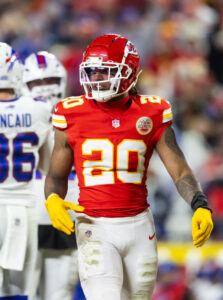 Helping the Chiefs to top-four defensive finishes over the past two seasons, Reid ranked – among regular starters – as a top-10 safety (per PFF) in coverage and run defense last season. He has posted five tackles for loss in each of the past two seasons and has been one of Steve Spagnuolo’s chess pieces. Reid played at least 160 snaps at free safety, in the box and in the slot last season and at least 250 in all three spots in 2023.
Helping the Chiefs to top-four defensive finishes over the past two seasons, Reid ranked – among regular starters – as a top-10 safety (per PFF) in coverage and run defense last season. He has posted five tackles for loss in each of the past two seasons and has been one of Steve Spagnuolo’s chess pieces. Reid played at least 160 snaps at free safety, in the box and in the slot last season and at least 250 in all three spots in 2023.
Reid’s all-around game helped the Chiefs continue to transition at corner and safety. Losing the three-year starter will be tough for Kansas City, though Spagnuolo’s ability to craft plug-and-play solutions should not be doubted – the team’s post-L’Jarius Sneed struggles notwithstanding – at this point.
The Cardinals gave Budda Baker an $18MM-per-year deal at 29. Reid is not in that class, and Baker is alone among eight-figure-per-year safeties in being on his third contract. A move northward from Reid’s previous $10.5MM AAV should exist. It is worth wondering if one would have been in play if Reid had signed a four-year Chiefs deal rather than a three-year accord back in 2022.
19. Teven Jenkins, G. Age in Week 1: 27
Jenkins’ successful conversion from tackle to guard led to a push on the former second-rounder’s behalf to secure a Bears extension. Such a crusade benefited Jaylon Johnson, but Jenkins did not deliver a comparable contract year. He is now days from free agency. Like a few of the guards in this year’s FA class, Jenkins brings questions. But he has delivered high-level work; that should generate extensive interest if/once the Ryan Pace draftee hits the market.
A rookie-year back injury caused 11 missed games, and with the Bears dissatisfied with Jenkins’ tackle form, he shifted inside under Matt Eberflus. Initially, the Bears did not like Jenkins there, either. But he ultimately won the starting right guard job in 2022. A lost season for the Bears became a launching pad for Jenkins, who impressed at the position. The Bears moved Jenkins to LG to accommodate eventual free agency bust Nate Davis, but the former still impressed. Jenkins ranked fourth in run block in rate in 2023 and was among the few guards to rank in the top 20 in pass block win rate as well, being tabbed 19th there.
 PFF has graded Jenkins as a top-15 guard in each of his starter seasons, but health issues will impact his market. While the back surgery buoys this total, Jenkins has missed 23 career games. A neck injury ended Jenkins’ 2022 season early, and he missed the first five games of the 2023 season with a leg issue. Ankle and rib issues provided lower hurdles in 2024.
PFF has graded Jenkins as a top-15 guard in each of his starter seasons, but health issues will impact his market. While the back surgery buoys this total, Jenkins has missed 23 career games. A neck injury ended Jenkins’ 2022 season early, and he missed the first five games of the 2023 season with a leg issue. Ankle and rib issues provided lower hurdles in 2024.
A true “prove it” contract is still difficult to envision, as Jenkins has been too productive to need another trial run. Even if his injury history does factor in here, many teams need guard help. And last year’s Day 1 spending binge showed what they are willing to pay for it.
20. Chase Young, EDGE. Age in Week 1: 26
Is this the offseason Young settles in and receives a notable multiyear offer, or is he headed down a Jadeveon Clowney path? Both are former top-two picks who dazzled at the college level before running into early-career knee trouble. Young has Clowney beat on this front, having seen a November 2021 ACL tear cost him over a year. Clowney did not sign a multiyear deal between his 2014 rookie pact and his 2024 Panthers agreement. That will be hard to beat, but Young also has not removed all doubt about his NFL path.
The Saints gave Young a contract themed around per-game roster bonuses, doing so while knowing the former Defensive Rookie of the Year needed neck surgery. Young quietly put together an interesting season, eclipsing his career-high with 21 QB hits and posting the most TFLs (eight) since his rookie season. The 46 pressures applied ranked 11th in the NFL. Young may not be the ace pass rusher most expected when he left Ohio State, but he can be a productive starter. Is that the former Heisman finalist’s ceiling or are teams convinced he is capable of more?
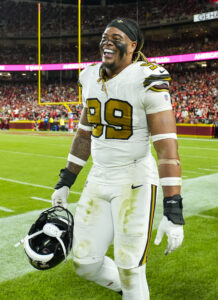 Young not only suffered an ACL tear, but a patellar tendon rupture extended his rehab timeline. These injuries may well have robbed him from an All-Pro career track. Age is still on Young’s side for now, but will he settle for a contract that will come in far south of where ex-Commanders bookend partner Montez Sweat’s Bears pact did? Sweat signed a $24MM-per-year deal, even though his peak form may not be where Young’s once was. Durability and consistency carried Sweat; Young presents an opposing case, and 2025 may still not provide a satisfying conclusion.
Young not only suffered an ACL tear, but a patellar tendon rupture extended his rehab timeline. These injuries may well have robbed him from an All-Pro career track. Age is still on Young’s side for now, but will he settle for a contract that will come in far south of where ex-Commanders bookend partner Montez Sweat’s Bears pact did? Sweat signed a $24MM-per-year deal, even though his peak form may not be where Young’s once was. Durability and consistency carried Sweat; Young presents an opposing case, and 2025 may still not provide a satisfying conclusion.
Had Young not gotten hurt, the Commanders would have probably extended him by now. Because he did, they passed on his fifth-year option. The five-year veteran is still too talented to keep out of the top half of this list, especially after he submitted a 17-game season on his New Orleans “prove it” deal.
Can Young show – now a year removed from his latest surgery – top-flight production remains in his tank? Will he settle for what could at least be a middle-class deal with guarantees covering two seasons, or did he show enough sustained health a team will provide an upper-crust long-term proposal? The Saints are interested in seeing what it takes to keep him, their latest run of cap trouble notwithstanding.
21. Aaron Banks, G. Age in Week 1: 28
As this guard crop brings questions, Banks presents less mystery. That is both good and bad. While the former 49ers second-round pick is on the older end for a first-time free agent, he started for three seasons and never sustained a significant injury in San Francisco.
After effectively redshirting in 2021, Banks was a pivotal part of the O-line the powered Christian McCaffrey to a strong 2022 second half and elevated him to the 2023 rushing title. Banks also was present for Brock Purdy’s stunning rise from Mr. Irrelevant to late-season replacement to the first QB to average at least 9.6 yards per attempt over a full season since 1998. Banks started 43 games over the past three seasons, never showing top-shelf ability but also impressing during stretches.
Effective in the run game more so as a pass-pro player, the Notre Dame alum will not command a top-market salary. The 49ers are still using a Trent Williams-and-scraps model in terms of O-line budgeting. With key defenders Dre Greenlaw and Talanoa Hufanga unsigned and Purdy due a $50MM-plus deal, Banks seems likely to move on. But the Kyle Shanahan system has outposts around the league. Former 49ers assistants, or staffers who run similar attacks, are stationed elsewhere. That should give Banks options.
22. Mekhi Becton, G/T. Age in Week 1: 26
Further entrenching Jeff Stoutland as one of the game’s best position coaches, Becton went from a free agency afterthought to a player who should command a starter-level salary – as a guard. The Eagles plucked Becton off last year’s market after the draft, needing to pay the ex-Jets LT bust just $2.75MM. Not quite the bargain Baun was, Becton still delivered tremendous value for the Eagles. After being classified as a wasted pick at No. 11 overall, Becton turned his career around at a new position.
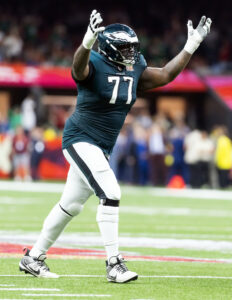 This has been quite the journey for the once-overweight Louisville product. He battled weight issues for three years in New York, partially marring his promising 2020 rookie season, and missed 33 of 34 games between the 2021 and ’22 seasons. Upon slimming down into the 340s in 2023, Becton did not impress at RT or LT, leading to the modest Eagles commitment. He then beat out Tyler Steen, who had been favored to take over at right guard after Cam Jurgens slid to center post-Jason Kelce, and missed just one game due to injury.
This has been quite the journey for the once-overweight Louisville product. He battled weight issues for three years in New York, partially marring his promising 2020 rookie season, and missed 33 of 34 games between the 2021 and ’22 seasons. Upon slimming down into the 340s in 2023, Becton did not impress at RT or LT, leading to the modest Eagles commitment. He then beat out Tyler Steen, who had been favored to take over at right guard after Cam Jurgens slid to center post-Jason Kelce, and missed just one game due to injury.
Becton shaking the injury concerns may be vital for his market, just as his 2024 play will be. Not included on last year’s top 50 FA list, Becton ranked 20th at guard (in PFF’s view) last season. The only outside hire among Philly’s front five joined in the effort to make Saquon Barkley a 2,000-yard rusher in 16 games. Becton also returned to Super Bowl LIX after a short injury absence, helping keep Jalen Hurts relatively clean while he sliced up a top-five Chiefs defense.
As you may recall from last year, this space touted the guard-to-free agency avenue. Last year’s class produced five eight-figure guard AAVs (Robert Hunt, Jonah Jackson, Kevin Dotson, Damien Lewis, Jon Runyan Jr.) – six if Michael Onwenu settles there in New England. This year’s group features a bit less stability, Becton included, but teams will have money to spend after the latest cap increase.
Becton will not be a candidate to go especially close to where Hunt did (5/100), but he upped his value considerably in Philly. He is interested in staying, but the Eagles have four upper-crust O-line salaries on their payroll. Even with their bevy of void years and option bonuses, it would seem the champs will not be able to afford a sizable Becton raise.
23. Charvarius Ward, CB. Age in Week 1: 29
Another player extolling the virtues of a three-year second contract, Ward is back on the market after a successful 49ers tenure. San Francisco looks to have made its choice at corner by extending its younger starter – Deommodore Lenoir – during the season. As a Brock Purdy payday nears, Ward appears set to leave the Bay Area. While indicating he would be interested in rejoining the Cowboys to be closer to home, Ward will generate interest from non-Texas-based teams as well. (And a Cowboys offer may prove elusive, as the team already has two starters locked in on the perimeter.)
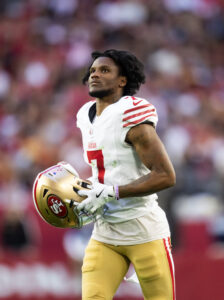 Among the handful of effective CB starters the Chiefs have let walk, Ward charted the most unlikely path to success. A former Cowboys UDFA traded straight up for guard Parker Ehinger in 2018, Ward became a $13.5MM-per-year player thanks to his work under Spagnuolo.
Among the handful of effective CB starters the Chiefs have let walk, Ward charted the most unlikely path to success. A former Cowboys UDFA traded straight up for guard Parker Ehinger in 2018, Ward became a $13.5MM-per-year player thanks to his work under Spagnuolo.
Ward’s 49ers tenure included three defensive coordinators. Ward earned second-team All-Pro honors under Steve Wilks in 2023, giving the 49ers a consistent outside stopper while they grappled with slot issues en route to a Super Bowl overtime loss. The team will still be looking for a No. 3 option post-Ward, though second-round pick Renardo Green would be the lead candidate to jump into the role of Lenoir’s wingman.
Last season also brought some concerns for Ward suitors. After allowing 56.8% and 54.1% completion rates as the closest defender in 2022 and ’23, Ward yielded 61.5% accuracy. This corresponded with a rise in passer rating allowed (116.6 – up from 2023’s 64.5 number). PFF had rated Ward as a top-six corner in both 2022 and ’23, but it dropped him to 93rd during Nick Sorensen’s season in charge. As Ward approaches 30, last season will factor into his market.
Even in a year featuring a host of CBs eyeing a second free agency payday, Ward may have seen 2024 reduce his value. With corners at this age bringing disparate markets, Adoree’ Jackson’s 2023 step back reminds how volatile these can be. Will Ward receive sufficient credit for his upper-echelon work in 2022 and ’23 or be docked significantly for his age and performance last season?
24. Tre’von Moehrig, S. Age in Week 1: 26
Inconsistent under Patrick Graham, the Raiders’ defense did finally produce a top-half ranking – for the first time since 2002 – in points under the enduring DC. Moehrig has served as one of Graham’s top pieces, though he has understandably been overlooked due to the Raiders’ on-field struggles and constant changes at GM, HC and QB. Moehrig, however, created momentum for himself last season and will at least bid to be this year’s second-highest-paid free agent safety.
Moehrig emerged from 2021 Day 2 draftee to become a four-year starter. The TCU alum made a successful transition from Gus Bradley’s defense to Graham’s, standing out most last season. Marcus Epps going down in Week 3 allowed for more Moehrig plays near the line of scrimmage (439 box snaps in 2024 compared to 326 in ’23), and he responded with a career-best 104 tackles to go with five TFLs and a sack. Moehrig also snared two interceptions, giving him five over the past two seasons.
Although the Raiders fell off their 2021 playoff pace – save for Antonio Pierce’s fluky second-half surge in 2023 – Moehrig ranks in the top 15 among safeties in terms of INTs and forced incompletion rate, per PFF, over the past two seasons. Not playing a part in strong defenses like Justin Reid nor rising to the All-Pro level like Talanoa Hufanga, Moehrig is still two years younger than the Chiefs starter and boasts a much healthier track record than the 49ers standout.
25. Khalil Mack, EDGE. Age in Week 1: 34
Mack was tied to a four-year rookie contract, and the Raiders picked up his fifth-year option. This gave the Bears – who acquired him via the blockbuster 2018 trade – an extra year of control once they authorized a then-defender-record payday on a six-year extension. After Mack played the final three years of that deal with the Chargers, he is hitting free agency for the first time at 34. This timeline will keep the potential Hall of Famer from securing a long-term deal, and Mack having considered retirement for a bit may make him a year-to-year proposition. But he is still one of the era’s best pass rushers. Excluding him here would be a bridge too far.
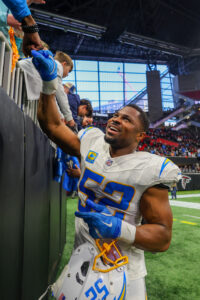 The Chargers want Mack back, especially as cutting Joey Bosa is again in play. But his Los Angeles resurgence – after a 2021 foot injury ended his Chicago tenure early – will create an interesting market. Mack sandwiched one of his best seasons between two reasonably productive slates, totaling 14 sacks between the 2022 and ’24 seasons and 17 in 2023. The former Defensive Player of the Year also forced five fumbles in 2023. Granted, a six-sack showing against the Raiders – in Aidan O’Connell’s first start –inflated Mack’s 2023 sack total, but he also tallied four more two-sack performances that season.
The Chargers want Mack back, especially as cutting Joey Bosa is again in play. But his Los Angeles resurgence – after a 2021 foot injury ended his Chicago tenure early – will create an interesting market. Mack sandwiched one of his best seasons between two reasonably productive slates, totaling 14 sacks between the 2022 and ’24 seasons and 17 in 2023. The former Defensive Player of the Year also forced five fumbles in 2023. Granted, a six-sack showing against the Raiders – in Aidan O’Connell’s first start –inflated Mack’s 2023 sack total, but he also tallied four more two-sack performances that season.
Last season brought a reduction from 22 QB hits to 15, and the 11-year veteran’s 22 pressures tied for 45th. But Mack played all but one regular-season game over the past three years, providing suitors with durability top peer Von Miller had not leading up to his six-year, $120MM Bills deal in 2022. The Bills did not benefit from that pact too much, as Miller’s 2022 ACL tear sidetracked his tenure with the team, and will likely either release the locked-in Hall of Famer if he does not agree to a substantial pay cut. Teams will be leery of Mack’s age, but he has one notable injury on his NFL medical sheet. A future in which he provides a late-career DeMarcus Ware-type impact is not out of the question.
Ware was 32 when he signed with the Broncos in 2014. Julius Peppers was 34 when he signed a three-year, $26MM deal (in 2014 money) with the Packers. Both played out their contracts. That would represent the best-case scenario, though Mack having debated retirement this offseason may limit him to a two-year deal. Mack has accomplished enough for guarantees to cover most of a two-year pact, however, registering 107.5 sacks (tied for 32nd in the sack era); a seven-sack season could move him into the top 25.
The Chargers reduced Mack’s workload considerably last season, dropping him from an 81% snap share to 61%. The 616 defensive plays were 139 fewer than any previous season Mack finished. While he may not be fully in the “situational rusher” stage of his career yet, that is coming soon. Still, the Eagles just showed how valuable pressuring QBs with four remains. That will matter for Mack, who can use his next contract to close a Canton case.
26. Darius Slayton, WR. Age in Week 1: 28
The Giants did not value Slayton beyond a two-year, $12MM deal in 2023, and that contract came after the Joe Schoen–Brian Daboll regime took the rare step of giving the wideout a pay cut on a rookie contract. Slayton also failed in his attempt to earn a raise last year, only seeing a modest incentive package bring him back into the fold during the Giants’ offseason program. Then again, this Giants regime also passed on paying Saquon Barkley and Xavier McKinney – as HBO frightened 31 other teams with its behind-the-scenes Giants footage – ahead of first-team All-Pro seasons.
 Excelling as a downfield threat and a de facto No. 1 receiver for the Giants for most of his first five seasons, Slayton can also make the argument he never played in a good offense. He served as Daniel Jones’ favorite target. As the Giants gave the struggling QB six seasons, that covered Slayton’s career. Teams could see value in a former fifth-round pick who tallied four 700-plus-yard seasons (all between 740 and 770) despite being trapped in a bottom-tier offense.
Excelling as a downfield threat and a de facto No. 1 receiver for the Giants for most of his first five seasons, Slayton can also make the argument he never played in a good offense. He served as Daniel Jones’ favorite target. As the Giants gave the struggling QB six seasons, that covered Slayton’s career. Teams could see value in a former fifth-round pick who tallied four 700-plus-yard seasons (all between 740 and 770) despite being trapped in a bottom-tier offense.
Then again, not too much has changed since Slayton could only score that two-year, $12MM deal in 2023. He did deliver a 770-yard showing in 2023, despite terrible quarterback play, and he has averaged between 14.7 and 15.7 yards per reception in every year but 2021 – a year with even worse Giants QB play. If Slayton is to make an argument based on untapped potential, this is the year.
Older receivers are plentiful on this market, one that will not include the re-franchise-tagged Tee Higgins. Diontae Johnson’s turbulent 2024 also takes the 28-year-old WR out of play for a multiyear deal, helping another player from the 2019 draft class. Slayton remains in his prime and does not bring any injury concerns. A midlevel WR2 contract could await, though that is the best-case scenario.
27. James Daniels, G. Age in Week 1: 27
The PFR pages contained no Daniels updates between May 2022 and April 2024; that is usually a good sign for an offensive lineman. The Steelers installed their 2022 free agency pickup at right guard and, for more than two seasons, could count on him. As the former Bears second-round pick was off to a strong start in his contract year, he suffered an Achilles tear. As a result, this is a tougher market to pinpoint. But Daniels does have some advantages coming into free agency.
He plays an increasingly valuable position, having made 84 starts (mostly at guard) as a pro. The Iowa alum, who is all but set to again ditch black and gold, also went down early last season. Suffering his injury in Week 4, Daniels has been on the rehab trail for nearly five months. Even though Daniels has played seven seasons, he will only turn 28 in September. A third contract that at least rivals his Pittsburgh pact (three years, $26.5MM) should be in play.
Daniels finished ninth in pass block win rate in his Steelers debut and was second only to Colts dynamo Quenton Nelson in run block win rate before going down last season. PFF ranked Daniels 33rd among guard regulars in 2023. This situation could produce a “prove it” deal, as there will be a handful of guards not coming off major injuries.
Daniels will also need to compete with Day 2 draft prospects, as teams weigh free agency or the college route at this position. The early injury coupled with positional versatility (1,200-plus snaps at LG in Chicago) and age work in Daniels’ favor to escape the “prove it” sector, however.
28. Russell Wilson, QB. Age in Week 1: 36
Wilson’s past three seasons have turned him from a player who was cruising to the Hall of Fame to one that will probably bring a debate. Wilson has shown major decline signs since the blockbuster Broncos trade, and his place as the greatest dead money hit – one Denver will deal with in 2025 as well – in NFL history is well known. The Steelers are leaning toward Justin Fields as the QB they would rather build around in 2025, but Wilson will have options – especially now that Matthew Stafford is off the board.
The 2022 season may be a line of demarcation for Wilson, but it was not all his fault. The Broncos erred by hiring an overmatched HC (Nathaniel Hackett), and he let Wilson and his camp run wild. The QB did not prove to know his skillset best, gaining weight to protect himself from hits and largely opting against using his legs. That season invited questions about Wilson’s legacy, even though he had carried the post-Legion of Boom Seahawks teams during Brian Schottenheimer’s OC period. Sean Payton also coaxed better play from the aging QB in 2023 – a 26-touchdown, eight-interception season that also brought increased run-game usage (341 yards, three TDs) – but the former top-quartile passer’s Denver exit hurt his stock again.
 Rather than guarantee Wilson’s 2025 base salary, the Broncos took an $83MM-plus dead money hit to finalize a messy divorce. The upcoming Aaron Rodgers release will rank second all time; it will check in at only $49MM. Wilson stuck the Broncos with the bill, signing with the Steelers for the veteran minimum. At barely $1MM, Wilson did provide value in Pittsburgh – but the team’s sluggish finish brought more questions.
Rather than guarantee Wilson’s 2025 base salary, the Broncos took an $83MM-plus dead money hit to finalize a messy divorce. The upcoming Aaron Rodgers release will rank second all time; it will check in at only $49MM. Wilson stuck the Broncos with the bill, signing with the Steelers for the veteran minimum. At barely $1MM, Wilson did provide value in Pittsburgh – but the team’s sluggish finish brought more questions.
Wilson’s QBR was nearly identical to his 2023 number (51.3 to 51.5); he ranked 21st in 2023 and 22nd in ’24. He bumped his yards per attempt to 7.4 from its 6.9 place in a checkdown-laden 2023 season and finished with a 16-5 TD-INT ratio. Wilson’s sack-taking penchant persisted, however, as he averaged three per game for a second straight year. The Steelers did not give Wilson a reliable second option beyond George Pickens, who remained volatile while also missing three games. That goes in defense of the scrutinized quarterback, but the Steelers going from 10-3 to 10-8 signals change is again likely.
As the ex-Seahawks great’s ceiling lowers, the Steelers appear to have made their Fields-over-Wilson assessment. This would still leave the NFL’s No. 3 all-time QB rusher, albeit a diminished version of him, with some options. Bridge avenues look to exist with the Giants, Jets and Raiders – with a Pete Carroll reunion likely on the table after Las Vegas struck out on Stafford – while the Titans trading down from No. 1 could open another door. Anthony Richardson’s accuracy woes could present another. The Giants, who hosted Wilson last year, and Raiders look like the most logical options.
Even if Wilson is nearing the end, 2025 should bring another starter chance. Wilson, who will be competing with Rodgers and Kirk Cousins – if/once the Falcons cut him – for these opportunities. A final chance to add a notable bullet point to his Canton case may hinge on his upcoming decision.
29. Ernest Jones, LB. Age in Week 1: 25
A player traded twice in two months – neither deal involving a pick north of Round 4 – landing here both illustrates Jones’ impact and perhaps a free agency crop not carrying as much top-end talent. But Jones excelled for three teams, the latter two after making a quick transition. The Seahawks want to keep the former Rams draftee, but he will have a decent market as a first-time UFA.
The Rams made Bobby Wagner a one-and-done, clearing the path for Jones to anchor their linebacking corps in 2023. He responded with his best statistical season, accumulating 145 tackles (14 for loss) and 4.5 sacks. Not big on investing much at linebacker, the Rams let Jones seek a trade without him having requested one. The Titans gave up a fifth-round pick for Jones just before the season, while the Seahawks sent Jerome Baker and a fourth for him before the deadline. Jones will seek a longer-term fit soon. Perhaps, like Leonard Williams, that will come via a Seattle re-signing after a deadline swap.
It made more sense for the Seahawks to pay Williams, as he plays a more important position and cost second- and fifth-round picks to acquire. Jones still played well under Mike Macdonald, whose defensive scheme made both Roquan Smith and Patrick Queen rich. Each Ravens LB booked a Pro Bowl invite in Macdonald’s Baltimore finale. After the Seahawks turned over their LB corps midseason, they are giving strong consideration to paying Jones – whom they inserted into the starting lineup immediately post-trade – and establishing some continuity.
30. Talanoa Hufanga, S. Age in Week 1: 26
Hufanga delivered one of this decade’s better safety seasons, soaring to the first-team All-Pro tier in his first starter season (2022), before running into persistent injury trouble. The latter chapters will impact Hufanga’s first free agency trip, but the promise of 2022 will also entice teams.
 As covered above, a host of teams willing to spend top dollar to staff their defensive back lines have not shown themselves in recent years. Money dried up after the top contract went off the board. This could be a special case, however. The former fifth-round pick made an immediate impact for the 2022 49ers, winning a job out of camp and producing six turnovers (four INTs, two forced fumbles) and adding two sacks, five TFLs and nine pass breakups. The USC product added three INTs before going down with a seminal ACL tear on Thanksgiving 2023.
As covered above, a host of teams willing to spend top dollar to staff their defensive back lines have not shown themselves in recent years. Money dried up after the top contract went off the board. This could be a special case, however. The former fifth-round pick made an immediate impact for the 2022 49ers, winning a job out of camp and producing six turnovers (four INTs, two forced fumbles) and adding two sacks, five TFLs and nine pass breakups. The USC product added three INTs before going down with a seminal ACL tear on Thanksgiving 2023.
The 49ers missed Hufanga down the stretch that season, as they struggled to defend the Packers, Lions and, late in Super Bowl LVIII, the Chiefs. Starting the 2024 season late due to the knee rehab effort, Hufanga suffered a concussion and a wrist injury that limited him upon return. He missed 10 games, running his number of total absences to 17 since becoming a starter. Upside still exists here, and the 49ers are believed to still want to re-sign the three-season starter. They will have company.
While the above-referenced Bates- and McKinney-dominated markets left little room for others to escape the position’s middle class, teams have still valued this job recently. The Buccaneers franchise-tagged Antoine Winfield Jr., and the Patriots transition-tagged Kyle Dugger. Both earned spring extensions. The Browns also paid Grant Delpit (three years, $36MM) late in the 2023 season, while the Cardinals have two safeties north of $12MM AAV (Budda Baker, Jalen Thompson).
Hufanga’s best-case scenario probably checks in around where the Pats went for Dugger (four years, $58MM), and he may need a “prove it” deal to reestablish value. But his 2022 performance could lead to a surprising number next week.
31. Jamien Sherwood, LB. Age in Week 1: 25
The Jets have interest in re-signing Sherwood, as they are expected to release C.J. Mosley. But other teams, the Patriots among them, will show interest after the former backup’s impactful 2024 stretch as a three-down linebacker. With Baun off the market, the likes of Sherwood, Jones and Bolton should move up the ladder on teams’ list. This one had Baun between Bolton and Jones prior to his Wednesday re-signing.
If Sherwood cannot agree on terms to stay in New York, the two most recent Jets defensive bosses – Robert Saleh, Jeff Ulbrich – landed defensive coordinator posts in the NFC. The 49ers and Falcons DCs figure to be monitoring their former pupil, as San Francisco could need a cheaper alternative to Dre Greenlaw. Will Sherwood be any cheaper? The former fifth-rounder drew some praise from NFL personnel early this offseason; he could do better than expected on the market.
Mostly playing behind Mosley and Quincy Williams with the Jets, Sherwood saw Mosley’s early-season injury allow for a spike in playing time last season. The former fifth-round pick capitalized, leading the NFL with 98 solo tackles and making 158 stops overall. This continued a strong Jets run at linebacker, as Williams had previously soared from waiver claim to All-Pro. Williams is still signed to a team-friendly contract; Sherwood has a chance to eclipse that deal.
Age is on the Auburn alum’s side, and he should be fresh after topping out at 194 snaps over his first three seasons. The experienced special-teamer will be viewed as a three-down LB somewhere soon – perhaps alongside Williams in New York. Sixteen off-ball ‘backers are earning between $6-$7MM on average; this includes Williams, who could only fetch $6MM per year. The Jets could have an issue with Williams if the latest cap spike leads to Sherwood out-earning him on a second contract with the team, but last season may well vault him beyond that AAV.
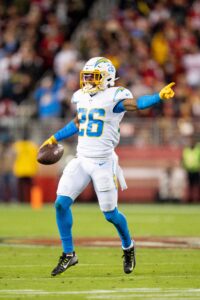 32. Asante Samuel Jr., CB. Age in Week 1: 25
32. Asante Samuel Jr., CB. Age in Week 1: 25
By default almost, this market will see its top two corners seeking a second contract – Adebo and Samuel – garner interest. Samuel has not been especially consistent, and he is coming off a four-game season. But he played extensively as a perimeter defender for the Chargers. Although Samuel did not have a chance to showcase contract-year form in Jesse Minter’s revitalized Bolts defense, the second-generation NFL corner played well during stretches for less successful Brandon Staley-overseen groups.
Samuel helped save the Chargers – to a degree, as their HC and GM were still fired – after their major J.C. Jackson miscalculation. After winning the slot job during the Bolts’ 2023 training camp, Samuel shifted back outside – where he played almost exclusively from 2021-22 – early in his third season. PFF graded the 5-10 cover man as a top-30 corner in 2022 and ’23, though he gave up seven touchdowns as the closest defender during the ’22 season. Samuel has shown playmaking ability, intercepting six passes from 2021-23 and totaling at least 11 passes defensed during each of those three seasons.
This year’s free agent cornerback crop skewing older will bode well for Samuel, even though he could not put together a good contract year. A stinger-type injury costing him so much time in 2024 could send out “prove it” deal vibes, but with the dearth of mid-20s corners carrying regular starter experience available, teams will need to look closely at Samuel and Adebo.
33. Haason Reddick, EDGE. Age in Week 1: 30
It is true the 2017 first-round pick never landed a deal commensurate with his production. His 50.5 sacks from 2020-23 ranked fourth in the NFL, yet his $15MM-per-year Eagles deal did not sniff the top tier. Much of this is because the Cardinals played Reddick out of position for most of his rookie contract, leading to a Panthers one-year stopover and the Eagles landing a player yet to prove he was a consistent ace pass rusher. After 2024, however, Reddick may have missed his window. He might have recognized this timing issue in the moment, hence the holdout, but did damage to his value last year.
During a rather chaotic Jets period – one that featured Woody Johnson handcuff lame-duck GM Joe Douglas – the Jets traded for Reddick but did not have a contract ready once he arrived. That effectively led to them throwing away a third-round pick for minimal production. Reddick was not the same in New York, registering one sack and three QB hits in 10 games post-holdout. That trade failure goes on the Jets, but Reddick also lost considerable value even from the middle-class EDGE deal to which he was attached.
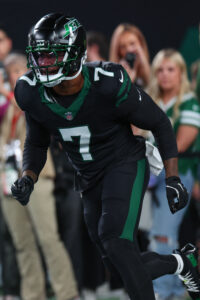 Standing his ground after he viewed the Jets as backtracking on their word – a purported plan to revisit extension talks before the season – Reddick missed seven games because of the holdout. Even if part of his midseason agreement addressed the fines and missed game checks, Reddick was nowhere close to the same player who had powered the Eagles to 70 sacks in 2022 – a 19.5-sack, six-forced-fumble season when the playoffs are counted – or the slightly lesser version who tallied 11 sacks in 2023. The Eagles dominated Super Bowl LIX without him, leaving this as one of the more difficult markets to peg.
Standing his ground after he viewed the Jets as backtracking on their word – a purported plan to revisit extension talks before the season – Reddick missed seven games because of the holdout. Even if part of his midseason agreement addressed the fines and missed game checks, Reddick was nowhere close to the same player who had powered the Eagles to 70 sacks in 2022 – a 19.5-sack, six-forced-fumble season when the playoffs are counted – or the slightly lesser version who tallied 11 sacks in 2023. The Eagles dominated Super Bowl LIX without him, leaving this as one of the more difficult markets to peg.
Ex-teammate Josh Sweat will do better than Reddick this year; he is nearly three years younger and does not have a clunker of a season like Reddick’s Jets one-off on his resume. Khalil Mack might outdo Reddick as well, even at 34. Still, Reddick is too talented to exclude. Joey Bosa becoming a free agent would affect Reddick, bumping him further down teams’ lists as well (though, Reddick’s clean injury history will work in his favor).
Reddick (31 in September) ranked fifth with 41 pressures in 2022 and then, even as the Eagles cratered defensively, was 13th (with 35) in 2023. One bad season should not sink his career, which should at least garner interest as a short-term solution.
34. Najee Harris, RB. Age in Week 1: 27
As two-high safety looks permeate the NFL this decade, rushing commitments have swung back. Though, that did not become a viable talking point until last season. The 2023 RB trends brought macro concerns about the position’s future, to the point a state-of-the-union Zoom meeting commenced. The slew of standouts relocating last year, however, made a major impact for certain teams.
 Saquon Barkley, of course, led the way. But Derrick Henry, Aaron Jones, Josh Jacobs and Joe Mixon mattered plenty to their 2024 teams’ success. Harris should benefit from this, but how other teams viewed their backfields will help him more.
Saquon Barkley, of course, led the way. But Derrick Henry, Aaron Jones, Josh Jacobs and Joe Mixon mattered plenty to their 2024 teams’ success. Harris should benefit from this, but how other teams viewed their backfields will help him more.
The Patriots, Panthers, Cardinals and Saints paid their starters. Alvin Kamara would have been a free agent this year, after the Saints moved off his previous contract, but the aging talent is now on a third New Orleans accord. Rhamondre Stevenson, James Conner and Chuba Hubbard were scheduled for 2025 free agency, but their teams authorized extensions. This both set a market for Harris – perhaps a floor? – and took backs out of the equation for teams in need to pursue.
Harris is more grinder than dazzling talent, but he is about as consistent as it gets at the position. The 2021 first-rounder has played through injuries to start every game in his four-year career. After a 1,200-yard rookie season, Harris finished with 1,034, 1,035 and 1,043. Next Gen Stats has not viewed him as an efficient ball-carrier, however, ranking him in the bottom third in rush yards over expected in 2024 and second-to-last in 2022. A finish in the top third of this metric did transpire in 2023, perhaps marking one of Harris’ few inconsistencies in a career that has also featured between six and eight rushing TDs each season.
Workload concerns may develop here, as the Miami alum also has 1,277 career touches. That did not impede the host of teams that invested eight-figure guarantees in Barkley, Jacobs and Mixon last year. Workload worries did form with Henry ($9MM at signing), who again proved many wrong.
Harris will also have to compete against a better college RB crop compared to last year, as teams will have cheaper options. But he is the top young veteran available. A deal in the range Hubbard, Stevenson and Conner set (between $8.3MM and $9.5MM per year) would be logical for Harris, who will likely aim to top Stevenson’s $17MM guarantee at signing. His being on the open market, whereas Stevenson’s money came via extension, will help in that quest.
35. Azeez Ojulari, EDGE. Age in Week 1: 25
Needing IR stays in each of his past three seasons, Ojulari will force front offices to consider that and his steady (when healthy) pass-rushing production. Despite missing 22 games during his rookie contract, Ojulari registered 22 sacks. He notched at least 5.5 in three of his four seasons, including an impact stretch during his contract year.
The Giants had tabbed Ojulari as the most notable EDGE investment during Dave Gettleman’s GM tenure. The team had primarily jettisoned its regulars (Jason Pierre-Paul, Olivier Vernon, Markus Golden) during that period, trading all three from 2019-21. Ojulari proved ready immediately, totaling eight sacks as a rookie. A summer 2022 calf injury blunted Ojulari’s momentum, limiting him for much of the season. Ankle trouble emerged in 2023 and then a season-ending toe issue hampered him last season. While these stumbles will work against the Georgia alum, the production-age combo might be too much to cool down his market to the “prove it” level.
Teams pursued Ojulari in trades for an extended span last year, as the Giants’ Brian Burns trade – coming two years after their No. 5 overall Kayvon Thibodeaux pick – let teams know Ojulari would be on the move in 2025. The Giants passed on clubs’ offers, having sought a fourth- or fifth-round pick. Those offers came amid a torrid stretch for the four-year veteran, who replaced an injured Thibodeaux and compiled five sacks during a three-game stretch (against the Steelers, Eagles and Bengals). Ojulari returned to the bench before being placed on IR.
Teams seeking a No. 2 edge rusher will likely show interest in a player who has excelled in spurts, but Ojulari would also be useful as a high-end rotational presence. After the Eagles sent their two-deep at Patrick Mahomes, an auxiliary rusher of this caliber will receive significant attention – even if his checkered injury past lowers a price ceiling. At 25, Ojulari’s best years should be ahead.
36. Camryn Bynum, S. Age in Week 1: 27
Safety brings several solutions for teams on this year’s market. As referenced above, the question will be how many teams are willing to make big investments in the position versus offering midlevel money or simply waiting for the draft. Bynum may be best known for operating as a key cog on the Viking defense’s post-turnover choreography, but he was certainly an important role player under Brian Flores’ No. 5-ranked unit.
Despite coming into the NFL two years later, Bynum is the same age as teammate Byron Murphy. That will not yet be a major issue for Bynum, but this represents an important time for the former fourth-round pick – a three-year starter in Minnesota. His age will make a noteworthy future free agency payday harder to come by, raising the stakes for him this year. Bynum remains on the Vikings’ radar, and the team showed that in part by passing on a $40.2MM Sam Darnold tag.
PFF viewed Bynum as taking a step back in his contract year, ranking him outside the top 60 after a 21st-place assessment in 2023. Though, Bynum has been durable (51 starts since 2022) and intercepted eight passes on his rookie deal. Bynum also forced three fumbles in 2023. He and Murphy were important pieces in helping the Vikings reassemble a capable defense after a woeful 2022 season under Ed Donatell.
Minnesota has plenty of questions to answer in its secondary, as Bynum, Murphy and Stephon Gilmore are out of contract. Unless the team wants to start over (as Harrison Smith is now 36), it will need to navigate this situation and get to work on re-signings. Murphy is on Minnesota’s radar; will there be room to keep the other young DB starter as well? The unattached safety contingent also housing mid- or late-20-somethings in Jevon Holland, Talanoa Hufanga, Tre’von Moehrig and Justin Reid crowds the free agent field a bit. Will there be enough teams to pay up, or will this market emulate the 2023 and ’24 classes in which safety money drops off quickly?
37. Amari Cooper, WR. Age in Week 1: 31
Cooper earned $100MM on his second contract by remaining effective throughout the deal. But the Cowboys’ reputation for convincing most of their players to sign long-term contracts hurt the decorated wide receiver, who is back in free agency after missing out on two market booms at his position. Cooper was tied to a five-year contract during the 2022 WR surge and could not secure better terms from the Browns while the market transformed again last year. Now, the refined route runner is coming off a stretch where he was not a difference-maker as a Bills rental.
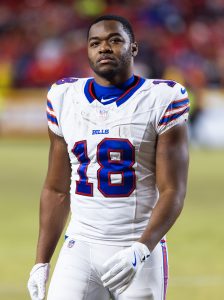 Four of this era’s premier separators are in this free agency class. Diontae Johnson crushed his value, while Keenan Allen – ahead of an age-33 season – is nearing retirement to the point he only wants to play in Chicago or Los Angeles. Stefon Diggs is coming off an ACL tear, limiting him ahead of an age-32 season. These situations should clear a path for Cooper, who was in top form as recently as 2023 upon helping Joe Flacco to a Comeback Player of the Year award somehow achieved in a five-game stretch. Cooper posted a career-high 1,250 receiving yards that season, helping convince the Bills to send the Browns a third-round pick last October.
Four of this era’s premier separators are in this free agency class. Diontae Johnson crushed his value, while Keenan Allen – ahead of an age-33 season – is nearing retirement to the point he only wants to play in Chicago or Los Angeles. Stefon Diggs is coming off an ACL tear, limiting him ahead of an age-32 season. These situations should clear a path for Cooper, who was in top form as recently as 2023 upon helping Joe Flacco to a Comeback Player of the Year award somehow achieved in a five-game stretch. Cooper posted a career-high 1,250 receiving yards that season, helping convince the Bills to send the Browns a third-round pick last October.
Even if Cooper drawing coverage helped Khalil Shakir, the most accomplished skill-position player for the AFC championship game entrant totaled just 297 receiving yards in eight games while only adding just 41 (on six catches) in the playoffs. Even as Buffalo leaned on James Cook more down the stretch, Cooper brings questions he would not have brought had he hit the market in 2023 or ’24. While the five-year Cowboys contract hampered Cooper, the Johnson and Diggs situations help him – as does Tee Higgins’ second franchise tag. Cooper would also benefit from the Buccaneers re-signing Chris Godwin before the market opened.
He of seven 1,000-yard seasons, Cooper has never exceeded 1,250. The former top-five pick had been a consistent performer for the Cowboys and Browns, showing immense promise as a Raider as well. Not quite a Hall of Fame candidate, Cooper was productive for three teams over several years. Was last season’s freefall a sign of a decline or a product of arriving in an increasingly run-oriented team fixated on aerial balance. Or both? The Bills have already paid Shakir, after drafting Keon Coleman, and have other extension priorities. Another deal is apparently in play, but would Cooper sign up for a similar role after the AFC East power used him infrequently (46% snap rate)?
Mike Evans signed a two-year, $41MM deal ahead of his age-31 season. DeAndre Hopkins checked in far lower (2/26) at 31. This should be a safe range for Cooper, whom teams will pursue as a No. 2 wideout. How good of a WR2 clubs view Cooper as will be a key skill-position subplot soon.
38. Will Fries, G. Age in Week 1: 27
Add Fries to the list of guard uncertainty on this market, as the Colts starter is coming off an uneven rookie contract but one that had him on an upward trajectory before a 2024 tibia fracture halted. The Colts may be trying to show restraint, per Chris Ballard at least, on retaining their own after their 2024 strategy failed. (Did it fail or has Indy just again bet on the wrong quarterback to anchor a homegrown nucleus?)
The Colts built from within up front in 2022, letting Mark Glowinski walk and not re-signing Eric Fisher. They installed Danny Pinter and Bernhard Raimann at RG and LT. This led to an uneven O-line performance, though little went right during the strange Jeff Saturday season. Fries took over as Indianapolis’ starting RG midseason and then started 17 games in 2023. Fries graded as PFF’s No. 32 overall guard in 2023, a season that featured surprising production from both Gardner Minshew and Zack Moss.
Fries would have landed higher on this list had he not gone down in 2024, as he had graded as the league’s second-best guard (per PFF) and had won his run- and pass-blocking matchups at a career-best rate (per ESPN) before the Week 5 setback. Fries’ inconsistent rookie-deal work also could reduce his market, but he is not competing against last year’s guard class. The lot of uncertain blockers on this year’s market should help him fare reasonably well.
39. Stefon Diggs, WR. Age in Week 1: 31
Last season did not go well for Diggs, who both suffered a torn ACL and saw the Bills move on so effectively without him that Josh Allen climbed to the MVP perch. The Texans made the unusual move of removing three seasons from Diggs’ contract, making him a 2025 free agent. The wide receiver’s camp drove this push, and it was framed around him being more motivated to excel in Houston. That seemed like a strange message to have out there, especially as the Bills had tired of their former No. 1 receiver’s antics. The October ACL tear then moved Diggs off the radar for a while.
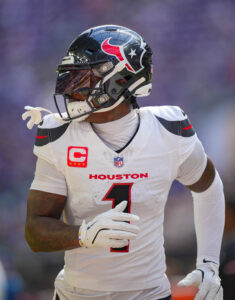 Diggs’ absence was an underrated storyline for the Texans, who did not see C.J. Stroud make the second-year leap they had hoped. Though, the 2023 Rookie of the Year had lost Diggs and then Tank Dell by Christmas. With the latter’s 2025 in jeopardy after a severe injury – one that came after a major 2023 injury and a gunshot wound earlier in 2024 – and the health issues are mounting. A Houston return will be on the radar for Diggs, as GM Nick Caserio expressed an interest in retaining his 2024 trade acquisition – even though it did not immediately pan out.
Diggs’ absence was an underrated storyline for the Texans, who did not see C.J. Stroud make the second-year leap they had hoped. Though, the 2023 Rookie of the Year had lost Diggs and then Tank Dell by Christmas. With the latter’s 2025 in jeopardy after a severe injury – one that came after a major 2023 injury and a gunshot wound earlier in 2024 – and the health issues are mounting. A Houston return will be on the radar for Diggs, as GM Nick Caserio expressed an interest in retaining his 2024 trade acquisition – even though it did not immediately pan out.
The Bills collected a 2025 second-round pick for a player they had centered their offense around from 2020 until late in the 2023 season. Diggs played the top supporting role in helping to elevate Allen from raw super-prospect to an MVP-caliber piece who has probably been the most important player to a team over the past two seasons. An ace route runner, Diggs went 3-for-4 in original-ballot Pro Bowl seasons in Buffalo and landed on two All-Pro teams. He twice surpassed 1,400 receiving yards, separating him from the other receivers in this class.
Diggs, however, saw his Bills role diminish as the team mounted a late-season charge in 2023. He also dropped a well-placed deep ball during a narrow divisional-round loss to the Chiefs. His ACL tear furthered a downward trajectory, but it did happen in October, giving the former Vikings draftee plenty of time to recover. Allen Robinson once fetched a high-end contract after a September ACL tear, though he was 25 at the time. Odell Beckham Jr. received $15MM fully guaranteed after missing a season due to a second ACL tear; he was 30 then. He of six straight 1,000-yard seasons from 2018-23, Diggs has had a better career than Beckham and should still attract considerable interest. A reality in which he waits to find the right team amid rehab also seems realistic.
An eight-figure guarantee on a one-year pact could await Diggs, but ACL tears are certainly not uncommon for free agents-to-be. A team betting on Diggs’ durable past (one missed game with Buffalo, zero seasons with more than three absences in Minnesota) and in need of a No. 2 weapon could go beyond “prove it” territory. Though, the WR market is filling up now. The releases of Tyler Lockett and Christian Kirk would stand to work against players like Diggs, perhaps suppressing the market for the older crop.
40. Dre Greenlaw, LB. Age in Week 1: 28
Will Greenlaw receive credit for past performance or was his 2024 enough to drop him into “prove it” territory. Even though Greenlaw is 28, a one-year deal to reestablish value would naturally cut into his hopes for a lucrative deal. He still can market an age-28 season this year; bouncing back and trying to sign a big-ticket deal closer to 30 may not yield a significant raise from where he was at on his second 49ers contract. San Francisco’s defensive decline without Greenlaw should at least garner scrutiny.
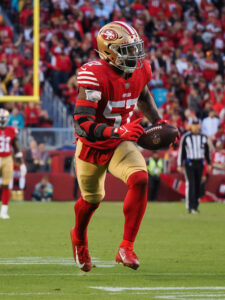 As the Chiefs steadily targeted Greenlaw replacement Oren Burks in a Super Bowl they won on the final play of overtime, a reasonable argument can be made that Greenlaw’s Achilles tear – while trotting onto the field in the first half – cost the 49ers a championship. Other factors contributed to San Francisco’s subsequent nosedive under one-and-done DC Nick Sorensen, but Greenlaw’s absence may have been chief among them. The 49ers, who completed a regrettable De’Vondre Campbell fill-in experiment, tumbled from third to 29th in scoring defense (while repeating an eighth-place showing in yardage even without Greenlaw or Javon Hargrave available for the most part).
As the Chiefs steadily targeted Greenlaw replacement Oren Burks in a Super Bowl they won on the final play of overtime, a reasonable argument can be made that Greenlaw’s Achilles tear – while trotting onto the field in the first half – cost the 49ers a championship. Other factors contributed to San Francisco’s subsequent nosedive under one-and-done DC Nick Sorensen, but Greenlaw’s absence may have been chief among them. The 49ers, who completed a regrettable De’Vondre Campbell fill-in experiment, tumbled from third to 29th in scoring defense (while repeating an eighth-place showing in yardage even without Greenlaw or Javon Hargrave available for the most part).
Greenlaw logged all of 34 defensive snaps last season, needing until December to be activated from the reserve/PUP list. He also missed 13 games in 2021 due to a recurring groin injury that required surgery. That injury opened the door for Azeez Al-Shaair to receive extended run alongside Fred Warner, allowing an extended audition that set up the UDFA’s eight-figure-per-year Texans deal down the road. Greenlaw is a better player, but circumstances have clouded his market.
Playing out a two-year, $16.4MM contract, Greenlaw can point to his 2022 and ’23 seasons as evidence he deserves a solid third contract now. PFF graded Greenlaw ninth among non-rush ‘backers in 2022 and 23rd in ’23. Set to see extensive time on Travis Kelce in Super Bowl LVIII, Greenlaw excels in coverage; he made 247 tackles from 2022-23 as well. The former fifth-round pick has flashed for long enough he should command a true market rather than settle for a one-year deal and a try at a 2026 payday.
41. Josh Myers, C. Age in Week 1: 27
Like Drew Dalman, Myers started as a rookie and kept a center job for four years. The Packers had let Corey Linsley walk in free agency, as he joined the Chargers, and drafted Myers as a low-cost successor. Green Bay only has one upper-echelon contract (Elgton Jenkins) on its O-line right now, but tackles Zach Tom and Rasheed Walker are in contract years. Tom has moved onto the extension radar. With Jordan Love signed to a $55MM-per-year deal, the Packers – who also have Josh Jacobs on a big-market contract and pass catchers Tucker Kraft and Jayden Reed building extension cases – may need to be conservative at center.
Fortunately for Green Bay, the center market is not particularly lucrative. Only three centers have cleared the $8MM AAV barrier in free agency over the past two years, though Dalman should soon be the fourth. Myers has a case to land in this range as well, especially given the newly unveiled $279.2MM salary ceiling. After missing 11 rookie-year games, the former second-round pick has suited up for all but one Packers contest since. He helped Jacobs and Aaron Jones to 1,100-yard rushing slates and has formed a rapport with Love during the duo’s two seasons together.
While Myers ranked 14th among all interior O-linemen in pass block win rate in 2023, PFF has never viewed him as even an average center. The advanced metrics site has never slotted the Ohio State alum higher than 26th at the position, ranking him as low as 38th (among players with enough snaps to qualify as regulars) last season. Myers has done enough to keep the Packers’ job, but he certainly has a prominent skeptic. With Myers wanting to remain a Packer, he may be affordable enough to retain.
42. Rasul Douglas, CB. Age in Week 1: 30
One or two losers will emerge from this glut of corners looking for a second free agency payday. Douglas’ age makes him a candidate to end up one, even with his position being in demand. Offering boom-or-bust traits, Douglas has also shown a consistent knack for creating turnovers. The 6-foot-2 CB has 19 career interceptions – 14 of those coming after he moved onto a steady career track in 2021 – and three pick-sixes. Douglas also helped the Bills out a jam over the past two years.
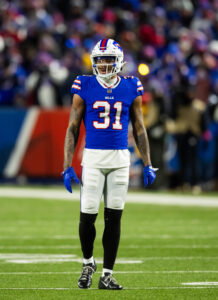 An Eagles draftee who saw a 48% snap rate for the Super Bowl LII-winning team in 2017, Douglas has been with seven teams already. His 2021 Packers stay keyed a reemergence, after a wayward stretch that culminated with the Cardinals waiving him. Douglas proceeded to intercept 14 passes between the 2021 and ’23 seasons, returning two for scores in 2021 and adding another in 2023. Douglas proved ill-equipped for the slot in 2022, when the Packers forced him inside to complement first-rounders Jaire Alexander and a then-healthy Eric Stokes. It did not take, but Douglas has been mostly effective on the boundary since Stokes’ midseason injury that season.
An Eagles draftee who saw a 48% snap rate for the Super Bowl LII-winning team in 2017, Douglas has been with seven teams already. His 2021 Packers stay keyed a reemergence, after a wayward stretch that culminated with the Cardinals waiving him. Douglas proceeded to intercept 14 passes between the 2021 and ’23 seasons, returning two for scores in 2021 and adding another in 2023. Douglas proved ill-equipped for the slot in 2022, when the Packers forced him inside to complement first-rounders Jaire Alexander and a then-healthy Eric Stokes. It did not take, but Douglas has been mostly effective on the boundary since Stokes’ midseason injury that season.
Douglas played well enough to attract the Bills’ attention at the 2023 deadline. Buffalo has not seen Kaiir Elam progress, as its aim for Trent McDuffie in the 2022 first round ended badly (as the Chiefs traded in front of them for the future All-Pro). The Douglas fix led to a third-rounder going to Green Bay on deadline day a year later. Douglas stepped in for a team that also lost Tre’Davious White once again. His replacement intercepted four passes with the Bills during a nine-game run and forced a fumble during a divisional-round loss to the Chiefs.
A better fit for a zone scheme, Douglas saw his coverage numbers spike in a more extended sample with the Bills. After an unsustainable (for non-2009 Darrelle Revises) 38.6 passer rating allowed as a Bill in 2023, Douglas was tagged with a 122.0 number and a 72% completion rate permitted last season, as Christian Benford became the Bills’ No. 1. The Bills have Benford on their extension radar, likely leading Douglas to either team No. 8 or a reunion somewhere.
Douglas is the oldest of this list’s cadre of corners. Beyond Jalen Ramsey, none of the top 15 CB contracts – a floor set at $13MM per year – went to players entering an age-30 season. The Chidobe Awuzie sector ($12MM AAV) would stand to be where Douglas would hope to land, but his market will be interesting, as there are a few players who fit the profile of settling here. Will there be enough money available for all of them next week or will a prominent player need to wait a while?
43. Malcolm Koonce, EDGE. Age in Week 1: 27
A situation where Koonce signs a lucrative one-year deal – a la Marcus Davenport’s 2023 Vikings agreement – may develop. Koonce will rely on his 2023 tape doing heavy lifting, as he did not make an impact in 2021 or ’22 and missed all of the ’24 slate due to a knee injury. He did flash brightly in 2023, however, potentially keeping the door open — as this year’s top pure edges are on the older side — for a multiyear pact.
As Chandler Jones became one of the worst free agency investments of the decade, the Raiders also did not see No. 7 overall pick Tyree Wilson step in as Maxx Crosby’s top sidekick. Koonce ended up barging into that role, and he finished with eight sacks and 17 QB hits despite starting only 11 games. Koonce’s production helped the Raiders snap their 20-year skid of bottom-half defensive rankings, with Patrick Graham’s unit finishing ninth in scoring.
Koonce also forced three fumbles that year, shining on a national stage by sacking Patrick Mahomes thrice during a Christmas Day upset – one that played the lead role in Antonio Pierce landing the full-time HC job. Koonce did not begin his sack binge until Week 9, as he saw an uptick in playing time around that point.
A small sample size could work against the former third-round pick, who has no other notable stretches beyond that half-season spurt. The Raiders also want to retain Koonce, and they have the second-most cap space. If they do not do so by Monday, this will be an unusual market due to such limited evidence of quality pass-rushing work.
44. Patrick Mekari, OL. Age in Week 1: 28
One of the league’s most versatile players, Mekari has seen at least 200 snaps at all five O-line positions. The Ravens had preferred him as a quality swingman, but after losing three starters from their 2023 front, the team needed the former UDFA to reprise his role as a starter. Mekari worked as both a starting right tackle and left guard for the Ravens in 2024, transitioning midseason but starting all 17 games during Lamar Jackson’s third first-team All-Pro year. Hitting free agency for the first time, Mekari could have a surprising market.
 It will, however, be interesting to see where teams view him. Mekari has logged at least 500 career snaps at both tackle positions, primarily playing outside from 2021-23. Serving as regular Ronnie Stanley injury insurance, Mekari graded 28th and 31st, respectively, among tackles in PFF’s view in 2022 and ’23.
It will, however, be interesting to see where teams view him. Mekari has logged at least 500 career snaps at both tackle positions, primarily playing outside from 2021-23. Serving as regular Ronnie Stanley injury insurance, Mekari graded 28th and 31st, respectively, among tackles in PFF’s view in 2022 and ’23.
Playing 822 snaps at left guard last season, Mekari checked in as a mid-pack player at the position. Not everyone agreed, as ESPN’s pass block win rate slotted Mekari fifth; he was charged with just one sack allowed in 2024. The Cal alum played center and right guard regularly for the Ravens in 2020 and managed 388 center snaps as a rookie in 2019. This is one of the most unusual resumes on this year’s market.
Mekari will not be anyone’s first choice at guard or tackle (or center) in free agency, but he will be a more affordable option compared to those players. He should garner a raise on his $5.15MM-per-year deal, with this being the six-year vet’s best shot at a high-seven-figure AAV. Mekari’s 53 career starts elevate him past swingman status, and the Ravens may need him as a starter again in 2025. They are aiming to keep him, and their interest in doing so may well depend on if they can retain Stanley. But Mekari will cost more this time around than he did when extended in December 2021.
45. Nate Hobbs, CB. Age in Week 1: 26.
Injuries have become a regular storyline for Hobbs, as he missed 17 games over the course of his rookie contract. He has also been a regular contributor in Las Vegas, mostly manning the slot for the Raiders. Hobbs drew interest from the 49ers at the 2023 trade deadline, when the eventual NFC champs passed on ultimately acquiring a cornerback. Now, some at the Combine have thrown out a Kenny Moore-like contract for the inconsistent and oft-unavailable cover man.
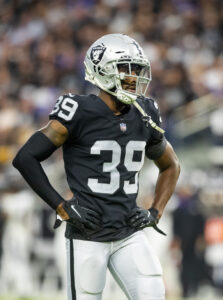 Nearly 10 years after Chris Harris bumped the slot corner market to $8.5MM per annum, it entered the 2024 offseason still south of eight figures annually. The NFL has collectively deemed it an auxiliary position, making a clear distinction between the versatile inside players – several of whom moonlight as perimeter defenders in base packages – and the pure outside stoppers.
Nearly 10 years after Chris Harris bumped the slot corner market to $8.5MM per annum, it entered the 2024 offseason still south of eight figures annually. The NFL has collectively deemed it an auxiliary position, making a clear distinction between the versatile inside players – several of whom moonlight as perimeter defenders in base packages – and the pure outside stoppers.
Moore hit $10MM per year on his third Colts contract, while Taron Johnson and Michael Carter topped it soon after by inking a three-year, $30.75MM Bills pact. Hobbs has not shown himself to be on these players’ level, but the cap has climbed by $24MM – and this market features a host of older corners, including slot CB Mike Hilton.
Hobbs played roughly three-fourths of his 2024 snaps inside; he was also slot-focused in 2023, logging 504 of his 775 defensive snaps there. PFF ranked Hobbs 73rd among CB regulars in 2024 but has placed him higher (42nd in 2023, fifth in 2021) in the past. The 6-foot-1 DB joined Moehrig in being a Raiders secondary staple since 2021; their upcoming contracts could give since-ousted GM Mike Mayock a couple of belated wins. Even though Hobbs has never posted a passer rating-allowed number south of 87.0 and was 12th among slot regulars in yards per target (6.3) last season, a market appears to be there for the former fourth-round pick.
While Adebo and Samuel will be sought as outside CBs, Hobbs joins Hilton as top inside FAs. Hobbs is five years younger than the Bengals defender. A shorter-term deal makes sense for all parties here, but Moore received $16MM at signing. Hobbs is three years younger than the Colts Pro Bowler was when he signed that deal.
46. Tershawn Wharton, DT. Age in Week 1: 27
If Milton Williams will benefit from Osa Odighizuwa being taken off the market, Wharton probably will to a lesser degree. Wharton has gained some momentum late and could follow Nick Bolton and Justin Reid off Kansas City’s defense. Unlike Bolton and Reid, however, Wharton has just one productive season to judge. That complicates this market, even though the former UDFA impressed in 2024.
A St. Louis native who played college football at Division II Missouri S&T, Wharton has spent his entire football career in the state. The Chiefs already have the NFL’s top DT deal (Chris Jones‘ whopping $31.75MM-per-year accord) on their books. It seems all but certain the team, which has used a $23.4MM franchise tag on Trey Smith, will not be able to retain Wharton. The latter following Khalen Saunders as a Jones sidekick did not pay off until last season, when he collected 6.5 regular-season sacks and two more in the playoffs. Wharton added a career-best seven TFLs.
Saunders only scored a three-year, $12.3MM contract (from the Saints) in 2023. Wharton can aim higher, as the cap has climbed significantly since even that point, but the 280-pound interior rusher held a part-time role on the Chiefs’ defense from 2020-23 and never topped two sacks or five QB hits in a season. PFF also graded Wharton poorly against the run last season. While he would provide a cheaper alternative to Williams, this will be a buyer-beware situation.
47. Ryan Kelly, C. Age in Week 1: 32
Kelly’s placement here comes down to if a team approves guarantees beyond Year 1. One of the NFL’s best centers, Kelly should command an AAV north of $10MM. He was at $12.4MM per with a full guarantee of $25.35MM upon signing a four-year extension in 2020. Three Pro Bowl accolades and a second-team All-Pro nod came Kelly’s way over the course of that contract.
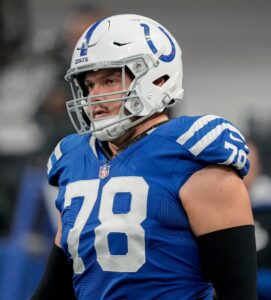 Going into Year 10 will hurt Kelly’s value; so will an injury-plagued 2024 season. But he had been more durable in prior years. The Alabama alum played in at least 14 games from 2019-23, shaking off early-career injury trouble and giving the Colts a strong interior O-line foundation alongside All-Pro LG Quenton Nelson. The latter remains Indianapolis’ anchor up front, as questions loom at center, right guard and right tackle – thanks to Braden Smith’s contract and finishing last season on the NFI list – loom this offseason.
Going into Year 10 will hurt Kelly’s value; so will an injury-plagued 2024 season. But he had been more durable in prior years. The Alabama alum played in at least 14 games from 2019-23, shaking off early-career injury trouble and giving the Colts a strong interior O-line foundation alongside All-Pro LG Quenton Nelson. The latter remains Indianapolis’ anchor up front, as questions loom at center, right guard and right tackle – thanks to Braden Smith’s contract and finishing last season on the NFI list – loom this offseason.
During his 10-game 2024 season – one interrupted by knee surgery – Kelly still placed 10th among all interior O-linemen in pass block win rate. PFF tabbed him eighth among center regulars in 2023. Kelly’s contributions largely went for naught on his second pact, as the Colts could not find consistent players to take his snaps, and a path to a contender would make sense at this juncture.
A handful of teams need center help, separating this situation from guard, but Kelly commanding a two-year deal is not difficult to foresee. Drew Dalman will see a bigger guarantee, but Kelly is by far this center market’s most accomplished performer.
48. Bobby Brown, DT. Age in Week 1: 25
Proving to be a solid run defender over the past two seasons, Brown will bring upside due to his age and having continued to fare well following Aaron Donald’s retirement. Donald made life easier for many Rams, but Brown held his own in a second season as a full-time starter. The Rams letting Super Bowl LVI starters A’Shawn Robinson and Greg Gaines walk in 2023 opened a door for Brown, who helped youngsters Kobie Turner and Braden Fiske operate last season.
The Rams fared worse against the run in 2024 compared to 2023, dropping from 12th to 22nd. Saquon Barkley’s midseason detonation certainly affected this, showing where Donald was missed. In a free agency that will bring another test to PFF’s assessments (and the value of run-stopping DTs), the advanced metrics site graded Brown 27th and 28th against the run over the past two seasons. While Barkley ran wild on the Rams, the team also used a fourth-down stop – one aided by Brown backfield penetration – to deter a Ken Walker attempt, leading to a Week 9 overtime win.
Starting 30 games over the past two years and not turning 25 until August, Brown should garner decent interest. Gaines was two years older when he settled for a one-year Buccaneers deal, while Sebastian Joseph-Day did much better (three years, $24MM) a year prior, with ex-49ers run stuffer D.J. Jones seeing $20MM guaranteed from the Broncos in 2022. Brown scoring a number closer to Joseph-Day would be a win for the former Day 3 draftee, and landing in that neighborhood is realistic, as the cap has increased by more than $70MM since that signing.
49. Josh Palmer, WR. Age in Week 1: 25
Both Darnell Mooney and Gabe Davis fetched $13MM per year as second-contract-seeking wideouts in 2024. Although Godwin and Slayton should outdo Palmer this year, both have already played out a second deal. More of Palmer’s prime remains, and the Canadian pass catcher has extensive seasoning as both an outside target and in the slot. The 6-foot-2 cog missing seven games in 2023, but his 58.1-yard average per game nearly equates to 1,000. That came during a season Justin Herbert did not finish.
 The Chargers counted on Palmer to fill in while dealing with Mike Williams or Keenan Allen injury absences during his rookie contract. Yet, with both starters off the roster in 2024, Jim Harbaugh reduced the contract-year contributor’s playing time. Palmer, who will turn 26 in September, has still put together back-to-back seasons of at least 15 yards per reception. He tallied 769 yards in 2022 — when Allen was down for much of the way with a hamstring issue — to help the Bolts to the playoffs. On a market featuring plenty of downward-trending standouts, Palmer brings sneaky value.
The Chargers counted on Palmer to fill in while dealing with Mike Williams or Keenan Allen injury absences during his rookie contract. Yet, with both starters off the roster in 2024, Jim Harbaugh reduced the contract-year contributor’s playing time. Palmer, who will turn 26 in September, has still put together back-to-back seasons of at least 15 yards per reception. He tallied 769 yards in 2022 — when Allen was down for much of the way with a hamstring issue — to help the Bolts to the playoffs. On a market featuring plenty of downward-trending standouts, Palmer brings sneaky value.
The Chargers still used Palmer plenty in 2024 but dropped his snap share from 75 to 65%, as Harbaugh and Greg Roman emphasized the run more than Joe Lombardi or Kellen Moore. The Bolts were linked to dangling Palmer in trades at last year’s deadline, pointing him out of town. Clubs will soon weigh a Palmer addition against a substandard WR draft class.
50. Juwan Johnson, TE. Age in Week 1: 28
Johnson’s views on orange-based uniform designs may soon be known, as Sean Payton’s team both needs tight end help (badly) and has displayed an affinity for adding his former Saints. Beyond an obvious Broncos fit, Johnson hits free agency in a bad year to want a veteran tight end. Tyler Conklin and Mike Gesicki – he of three straight one-year deals – are the other notable options at the position. Seventeen tight ends are on deals that came with at least $15MM guaranteed; most of them did so without the benefit of free agency.
For what it’s worth, Johnson also broke through as a receiving weapon after Payton resigned his Saints post. Granted, the team was running his old offense under Pete Carmichael. But still, Johnson did not carry a big role in New Orleans’ passing game during Payton’s tenure. Over the past three years, however, Johnson has produced two 500-plus-yard seasons and totaled 14 touchdowns. The converted wideout has shown consistent ability to break away after the catch, with 38.7% of his yardage coming post-reception in 2024.
Denver will not be the only team needing a tight end. But players like Johnson also need to be measured against a draft investment. This happens to be a good year at the position in the draft. Teams out of range for Penn State’s Tyler Warren can target Michigan’s Colston Loveland, LSU’s Mason Taylor and Miami’s Elijah Arroyo in the first two rounds. While that will work against Johnson and Co., the veteran Saints cog has shown enough flashes to warrant a middling tight end deal soon.

